



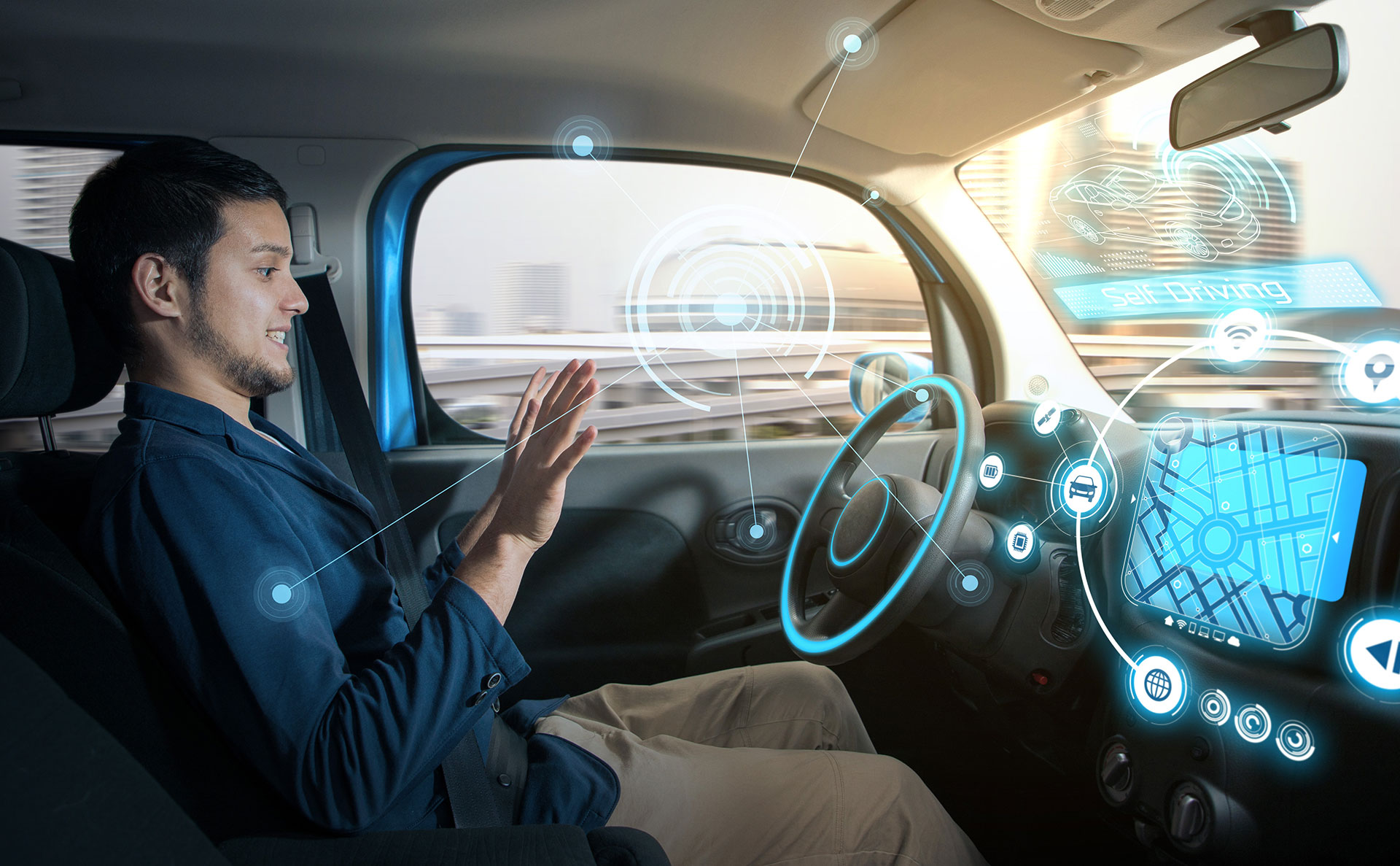
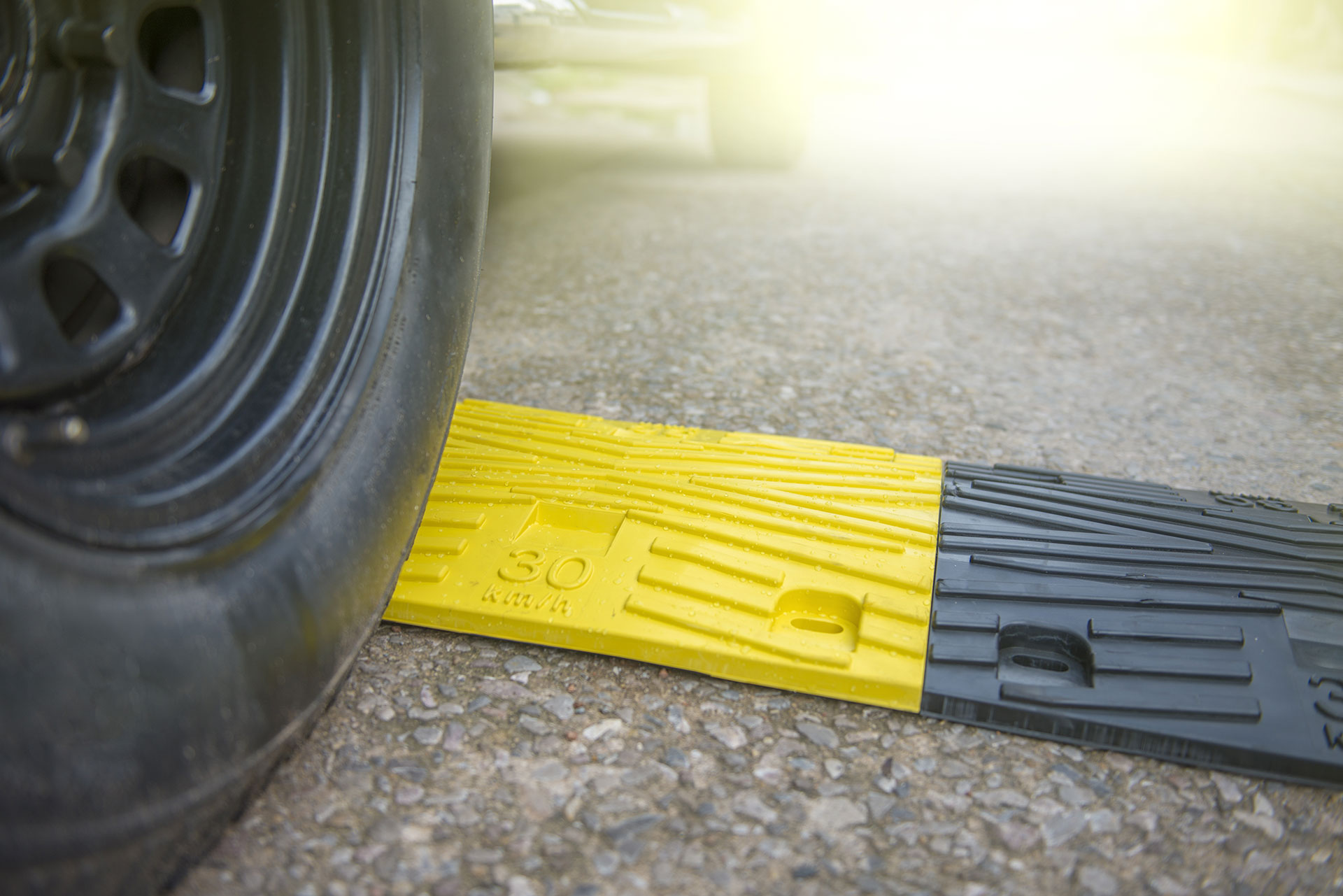
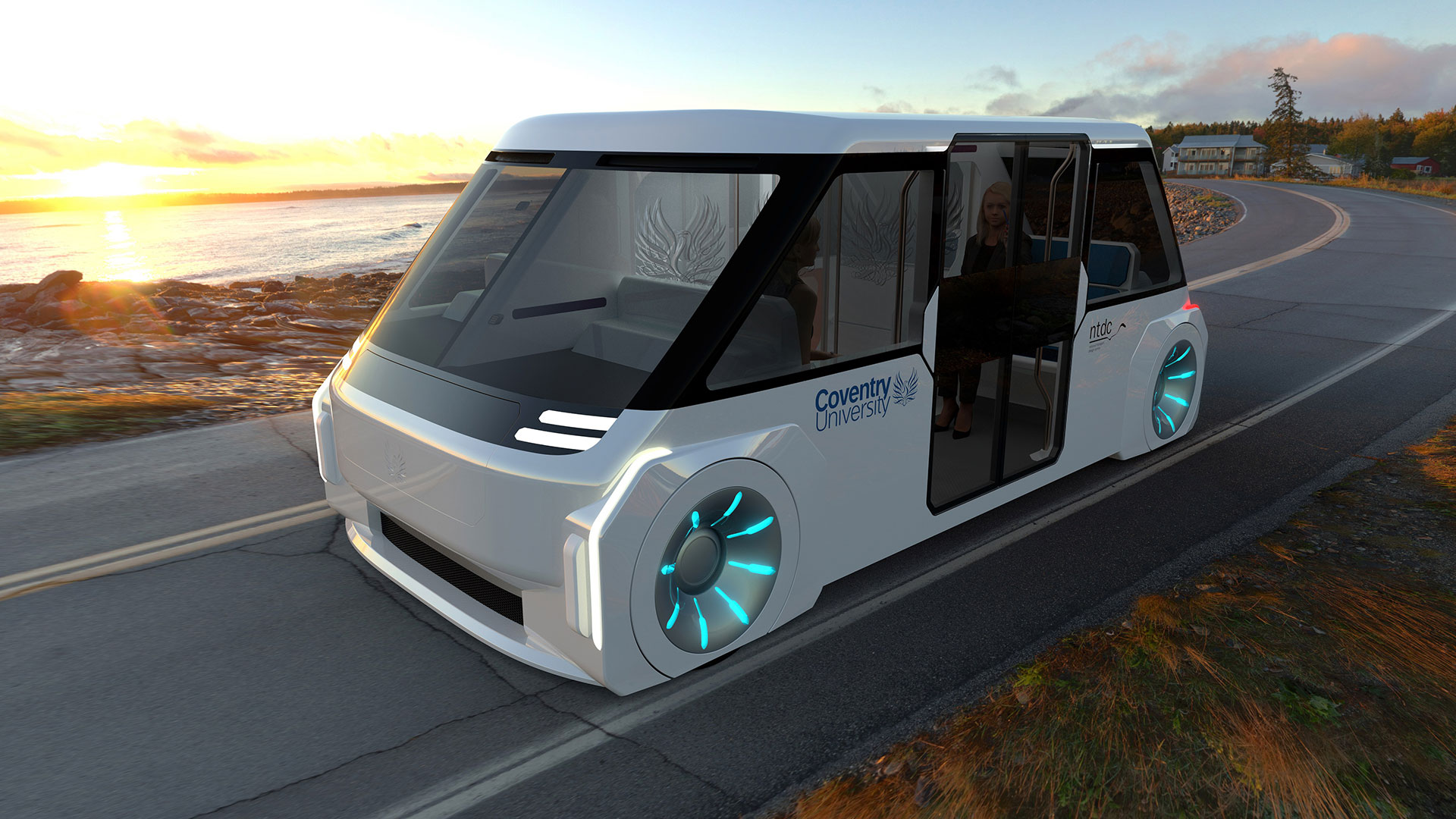
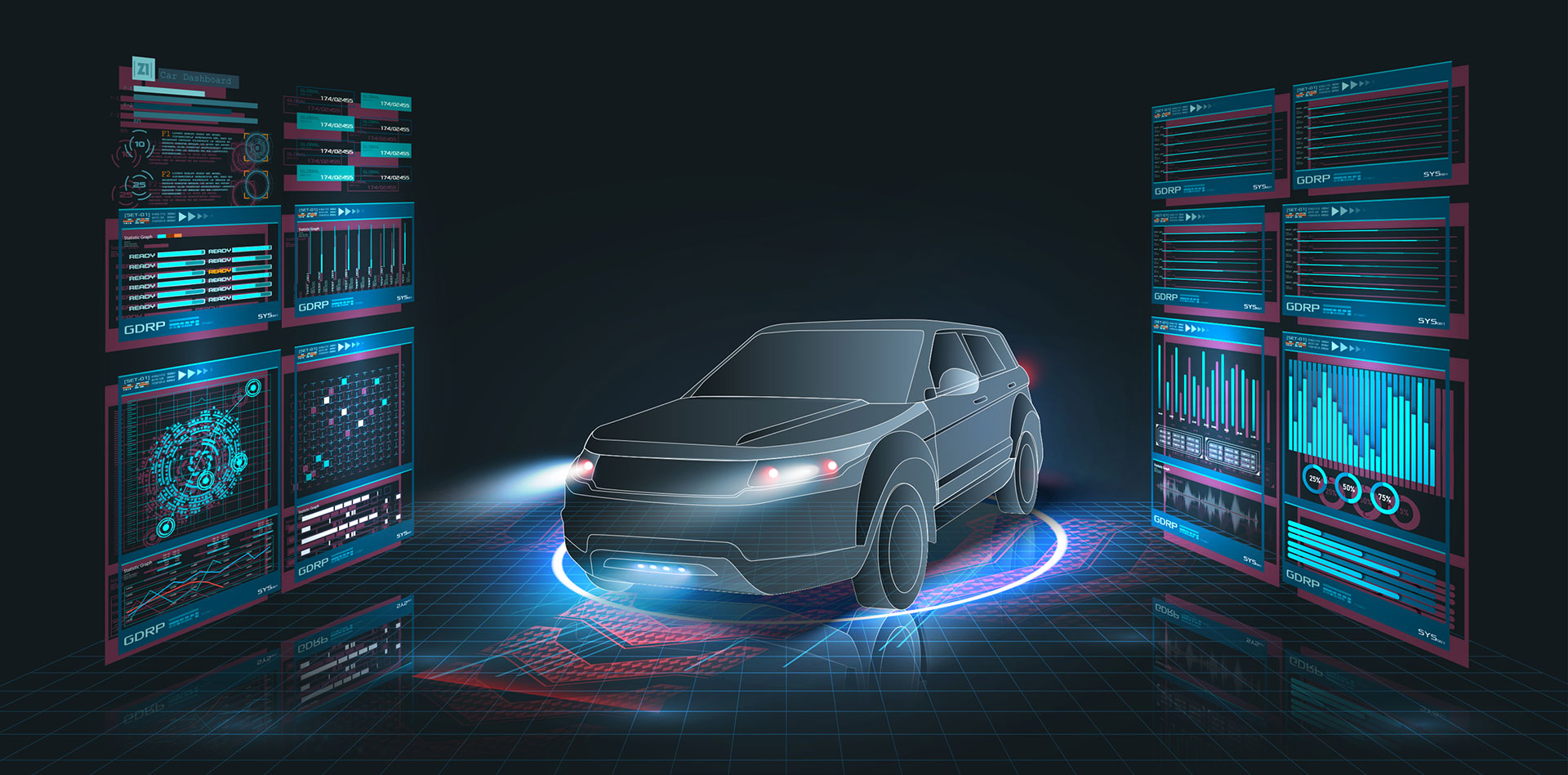



By Natalie Sauber | Market Intelligence and Future Mobility| Arcadis
Although we are once again starting to take space exploration more seriously, the main improvements in our lives appear to come in the form of more addicting social media algorithms, as so aptly explained in Netflix‘ latest documentary “The Social Dilemma”. At the same time, political debate is preoccupied by questions of social justice and discussions about breaking up dominant internet companies, ignoring anything new and exciting. To say the physical world has become stale is probably an understatement and as Marc Andreessen rightly observed at the beginning of this year, “It’s time to build”. Unfortunately, we tend to optimise within know constraints and often take the status quotas a given.
Saying that, this article is meant to shine a spotlight on an exciting development in an area where one might least expect it. After all, sometimes it is good to bring a combination of science fiction and steampunk back into our lives.
Taking long-distance logistics as an example, the general assumption seems to be that a plane offers speed and is expensive, while shipping is very cheap but will take a long time. This works reasonably well, as we can decide upon the trade-off between speed and cost on a case-by-case basis. For instance, urgent medical equipment might be more expensive but will arrive quickly by plane, but clothing is relatively cheap and will often spend many weeks on the waterways between Europe and Asia.
During a time when freight transport has become the largest single source of developed countries greenhouse gas emissions (close to a whopping 10%) and realistic attempts to develop zero-carbon technology are in their infancy, it is becoming increasingly important to think about potential alternatives.
Luckily, it now appears as though there is a new option on the horizon, able to offer an interesting trade-off along the speed and cost axis, while at the same time bringing significant environmental advantages. This combination could make the airship an important part of tomorrow’s logistics framework.

II
While we are only used to seeing airships as advertising vehicle for the likes of Goodyear and MetLife, these giant vessels used to play a significant historical role for transport and within our aerial defence efforts. Unfortunately, the gruesome destruction of the Hindenburg in 1937 (whose hydrogen envelope caught fire during a docking attempt) almost single-handedly ended civilian airship travel and most commercial applications. Given recent technological improvements however, it is now time to seriously consider the advantages today’s designs could bring to the logistics industry.
III
Despite the multitude of compelling arguments for the use of airships, not everyone is optimistic. Some of the more comment arguments are voiced along the following lines:
The compelling arguments in favour of use for logistic purposes put airships in a class of technology, with nuclear power and space travel, all which are experiencing an unexpected, but very welcome, modern renaissance.
IV
When comparing airships to other long-haul logistics options, it is important to look at the economics. Although an overly crude concept, it is possible to look at the cost and speed of transport on a per tonne-km basis. Cargo planes can generally fly above 800km/h, but costs – considering the age of common cargo planes – are around $1. Ships on the other hand often travel at speeds of up to 20km/h, with costs that are lower by a factor of a hundred at 1c per tonne-km.
How does this compare to potential future airships? Given that we do not have experience to guide us, we can instead look at projects in development. Going of work done by the blog ‚The Roadless Revolution‘, this would lead us to conclude that on a comparative basis, airships would likely cost between 6-10c per tonne-km and operate at between 50-150km/h. This should immediately make clear why airships could offer such a compelling proposition in the future.
V
After having looked at the economics of airships, the next question should turn to the potential market opportunity. After all the investment only makes sense if companies could see a sufficiently large market in the future. The latest number for world GDP stands at about $81 trillion USD per year. Assuming over time each country approximates the US’ 9% GDP share of transportation and about 10% of global freight migrates to airships, this would equate to a $720 billion revenue industry, before any future growth and a clear reason to pursue the development.
At present there are several companies in the U.S. and Europe trying to stage a comeback for airships, across logistics and luxury travel.
Luxury tourism is the latest (and perhaps the most intriguing) attempt to make airships a viable economic proposition. A small UK-based company founded in 2007 has emerged as the front-runner in a race to bring environment-friendly versions of dirigible travel back to the skies. Hybrid Air Vehicles (HAV) with its flagship the 92-metre Airlander 10 airship is selling tickets for a day tour across the North Pole in 2023. Tickets started at $62,000 per two-person cabin; they have now climbed to $79,000.
The Airlander will not be alone in the skies either. Earlier this year, French airship company Flying Whales received $320 million in funding from the government of Quebec to build cargo-carrying Zeppelins. The airships have been designed in such a way that they are able to transport up to 60 metric tons of goods at altitudes of close to 3,000 meters through hard-to-reach areas with commercial production to begin in 2025. Since the French airship is a VTOL (vertical take-off and landing), it will not require any extra infrastructure to operate, allowing it to serve more remote locations without harming the environment.
Google co-founder Sergey Brin has also started an airship company. Brin’s humanitarian airship company LTA (lighter than air) is trying to reinvent airships for the 21st century to be used for humanitarian missions. At the same time, Skunk Works, the innovation arm of defence giant Lockheed Martin, is designing airships to carry medical supplies to remote locations.
If these airships can take off despite carrying a legacy of failed projects and distrust from the public in lieu of economic justifications that still seem more wishful thinking than reality—it might just be the return of the zeppelin.

By Jeff Davis, Senior Director, Government Relations and Public Policy at BlackBerry
Humans have an issue with trust. While innate to our nature, trust is also something that must be earned over time, and once lost it can take a long time to get it back, if at all. This is particularly true where new technologies like autonomous vehicle safety are concerned. We see time and again that regardless of the extensive number of hours that autonomous vehicle testing is done safely, a single incident can overwhelm a news cycle.
Think of last year’s Uber crash or the more recent Tesla crashes. They do not become associated with a single company, rather, they become a trust challenge for a whole industry.
New Technologies Bring New Challenges to Safety and Security
In the findings from an investigation into one crash, a Tesla was found to have repeatedly made maneuvers at one particular area of highway that eventually resulted in the vehicle crashing into a concrete barrier. On several occasions, the driver was able to maintain control and override the maneuvers to safely keep the vehicle in lane, but during the final incident, the driver was distracted and was not able to avoid the crash. Of further concern is that the car first increased speed from 62 mph to 71 mph just prior to steering into the barrier.

BlackBerry’s pedigree in safety, security, and continued innovation has led to its QNX technology being embedded with more than 45 OEMs and more than 175 million vehicles on the road today.
In an investigation by the National Transportation Safety Board (NTSB) of an unrelated accident, the NTSB found that the fatal collision of a car with autonomous driving features and a slow-moving truck was also partly the result of the driver not regaining control of the vehicle in time. It referenced an earlier accident where systems that “underpin AEB systems have only been trained to recognize the rear of other vehicles… in part because radar-based systems have trouble distinguishing objects in the road from objects that are merely near the road."
This represents a challenge with autonomous vehicle technology in its current state. Drivers tend to lose focus on the road, giving too much responsibility to low-level automation features, allowing technology to work in a domain beyond its capabilities. The end results are both tragic and fear-inducing. Distracted driving is just as life-threatening in a vehicle with automated features as it is in a conventional vehicle.
The misunderstanding lies on two fronts: first, some companies are overly bullish in their confidence of the self-driving features of the car, leaving their consumers at risk. This is miseducation, and it is dangerous in itself. The second inappropriate interaction comes from a misunderstanding of what autonomous features are designed to do in today’s vehicles. Lower level autonomy is there to augment a human driver, not replace them. It helps the driver with things we humans are really bad at, like paying attention for long periods of time, or checking all our blind spots.

BlackBerry had a big presence at the 2020 edition of the Consumer Electronics Show in Las Vegas.
However, at this point, there are a lot of things that humans do better than cars, like contextual understanding and object identification. In any case, the technology gets blamed much more than the humans do, and it results in a lack of trust that hurts the entire industry.
Mistrust, with a Side of Mistrust
Another modern phenomenon that impacts the trust of a consumer is a security incident, and if a misbehaving autonomous feature was the result of a cyberattack, the court of popular opinion could put an end to autonomous vehicles. Even with drivers maintaining control, there is a risk that these highly connected vehicles could be infected with malware when connecting to a mobile device, downloading traffic reports, or with updates for a potential maintenance issue by the manufacturer, which could have devastating consequences.
The mind can go to several nightmare scenarios: attackers crashing cars into each other, threat actors stopping cars on the highway and blocking major arteries, and other similar scenarios. But more likely, attackers could use malware to steal payment credentials stored in the car's systems for use in automatic payments at gas stations, drive-through restaurants, car washes, or similar businesses where the driver may not need to exit the vehicle to make a purchase.
And an almost-inevitable scenario could be that marketing data collection companies could monitor communications to know where you drive and when, how long you stayed, what communications you saw or listened to, etc.
Adapting Current Security Solutions to New Technologies
This brings the world of connected and autonomous vehicles right up there with every network that requires the protections offered by security technologies such as firewalls, antivirus (EPP), endpoint detection and response (EDR), distributed ledger technology (DLT), etc. The massive mobile endpoint that is the modern vehicle comes with more than its share of security concerns and begs the question: are today's security solutions going to translate well to an autonomous vehicle?

In 2019, BlackBerry announced an investment of $310.5 million dollars (with $40 million provided by the Government of Canada) to help further the advancement of safe and secure software systems for the next generation of connected and autonomous vehicles.
On the one hand, that car should appear to those security systems as one big network, albeit one that weighs more than a ton and can move faster than 100 mph. As a practical matter, though, the nature of the systems that make up that vehicle are going to be radically different. As such, manufacturers must work closely with firms on advanced security systems that are designed to work specifically with autonomous vehicles.
The future of transportation and mobility is one of the most exciting fields of technology, one that is both growing rapidly and producing advancements that occur at dizzying speeds.
It is critical that safety and security are top of mind from the beginning of the process and throughout the development and production processes if the industry is going to foster and maintain the trust required for the adoption of these technologies. Safety, security, and trust are fundamental to this effort and inseparable in their importance.
About Jeff Davis, Currently, Senior Director, Government Relations and Public Policy at BlackBerry, Jeff Davis oversees the company’s smart transportation initiatives, working to grow the number of active pilots we’re involved in and representing the organization from an advocacy standpoint in industry groups such as The Intelligent Transportation Society of America (ITSA), Partners for Automated Vehicle Education (PAVE), ERTICO and the Automotive Information Sharing and Analysis Center (Auto-ISAC), and in directing BlackBerry’s development in smart transportation. He previously served as a Senior Vice President at ITSA, the nation’s largest organization dedicated to advancing the research, development and deployment of Intelligent Transportation Systems (ITS). Prior to that he developed new programs throughout the Department of Defense, as a Marine officer and contracted civilian.
Jeff has worked in technical and market development for 11 years beginning in defense as a project officer on several development and conceptual efforts across the operational and tactical spectrum, he moved on to oversee the creation and execution of comprehensive enterprise programs within the Navy and Marine Corps. For the past four years Jeff has focused solely on smart transportation including the implementation of cybersecurity practices, integration of connected and autonomous vehicles, and business cases around Mobility as a Service (MaaS).
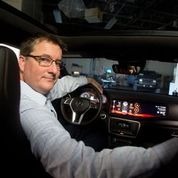
In the race to produce self-driving cars, the ability to build consumer trust is as important as the ability to build the technology itself. For the driving public to adopt autonomous vehicles en masse, it’s not enough to simply trust the technologies – people must also trust that the companies building these technologies will act responsibly. It is a moral imperative for those of us within the industry that are advancing this fast approaching future to make sure it is both safe and secure.

Local authorities in the UK must take an active role in e-scooter deployment and learn from previous cases across Europe to maximise the benefits and ensure a smooth integration with today’s transport network.
You'll have seen cycle lanes popping up across town and city centres in the UK since the start of the coronavirus lockdown, erected to aid social distancing and enable journeys without the need for public transport where the risk of cross-contamination is greater.
This move from local authorities shows the rising demand for micro-mobility - short-distance transport options like bikes and scooters, sometimes with electric motors - which are becoming a more practical proposition for a broader range of people.
As a result, and in light of the coronavirus outbreak, the UK Government brought forward trials of electric powered scooters (e-scooters) to give the public, primarily key workers, an alternative form of low carbon transportation to aid a green recovery.
Pioneered in 2018 by Lime and Bird in the United States, e-scooters are intended as a sustainable method of ‘first and last mile’ transportation and have grown in popularity ever since, particularly with commuters between bus or train stations and places of work or university, or lone travellers making short journeys where a car or taxi has previously been the preferred option.
The UK trials are limited to rental e-scooters, rather than private ownership, and in specific towns and cities with temporary laws enacted to allow deployment and allow users to ride them legally.
Riders must be over the age of 16 with a valid driver's licence while the e-scooters are limited to 55 kg, 25 kph (15.5 mph), and roads and cycle lanes - helmets are recommended but are not a legal requirement.
Rental e-scooters are predominantly dockless which offers users the convenience and freedom to start and end their journeys at any location (within a zone restricted by GPS) without parking fees; typically, devices with low charge are collected, recharged and redeployed to hotspots overnight.
Historically, regulation came after deployment, causing social and transport problems, however the UK trials, expected to last up to one year, give local authorities the opportunity to assess the impacts and use the results to influence future laws.
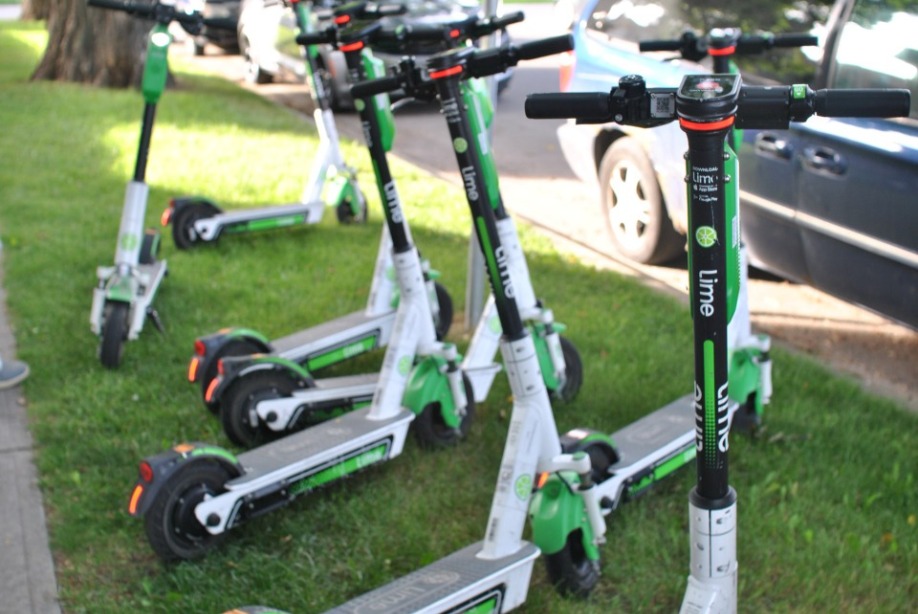
As communities adjust to new and disruptive transport methods, those impacts should be evaluated in light of the benefits to society and the environment.
Taking people out of cars reduces congestion which improves journey times and benefits local air quality, therefore policy should promote e-scooters as an alternative to cars rather than public transport or active travel (walking and cycling).
Data from various e-scooter studies shows that around 30% of e-scooter journeys replace car travel (a combination of private car use and ride-hail e.g. taxi, Uber or Lyft), 50% of rides replace active travel, 12.5% of rides replace public transport and 7.5% of users would not have made the trip if e-scooters were not available.
Using those figures for modal shift, Cenex has calculated that e-scooters reduce CO2 emissions by 45% across all journeys.
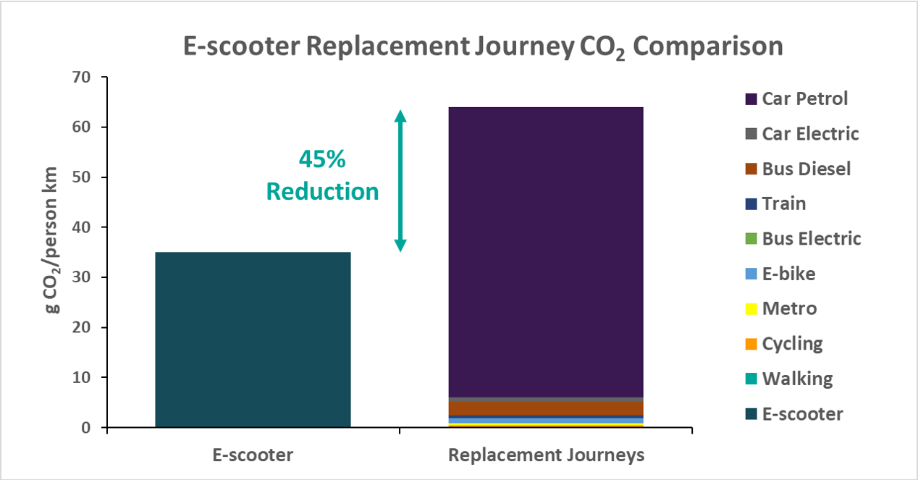
Figure 1: Calculated CO2 impact across all e-scooter journeys
Car journeys have the largest carbon footprint, therefore the higher the percentage of car travel replaced by e-scooter journeys, the greater the environmental benefit, whereas e-scooter rides that replace active travel increase the carbon footprint of the transport network.
The downside to rental e-scooters is the necessity to recharge, which can also have a negative environmental impact.
By the end of each day, e-scooters can be dispersed across a large area, creating inefficient and long travel patterns for collection vehicles (typically with internal combustion engines) which must be accounted for in the total emissions output.
Data from Voi Technology shows that this has improved over time, with life-cycle CO2 reducing by 70% since January 2019 - from 120 g CO2 equivalent per km to 35 g in March 2020 - by switching to renewable electricity for charging, using an electric cargo bike to replace batteries in situ, and incentivising rider behaviour to improve efficiency.
Continued emission savings are vital as the UK targets net zero by 2050 and any small improvements are positive steps towards achieving this.
Replacing car journeys with e-scooters also benefits other road users, as congestion eases and journey times improve.
Global vehicle numbers currently grow by around 80 million vehicles per year, causing significant increases in the travel time for drivers in slow, stop-start traffic, especially during peak travel times during the morning and afternoon.
In the UK, 58% of car journeys are less than 5 miles (in urban environments 69% of car journeys are less than 3 miles) while congestion causes an average of 178 lost hours per year in the UK and an associated cost of £8 billion.
Their compact nature and operability make e-scooters ideal for short journeys in urban environments - popping into town for lunch, short commutes to work or getting around university campus - and can be quicker than driving through city traffic, especially with dockless parking.
The price points of e-scooters open them to citizens from a broader range of socioeconomic status, as rentals have no capital outlay and can cost as little as £2 for a short trip - a similar cost to parking a car.
“E-scooters are here to stay”
David Philipson, Transport Technical Specialist at Cenex:
“E-scooters have their place in the transport networks of the present and future, offering first and last mile travel solutions that are inclusive and sustainable.
"However, without appropriate implementation, management, and regulation they can disrupt the transport network, and the city as a whole, in a negative way.
“It is evident that e-scooters are here to stay, with operators committed to continual improvements for the benefit of both the environment and society.
"Though still in its infancy as an industry, e-scooters are already providing a genuine, affordable, green solution to private car use in city centres which will only improve over time.
“Local authorities need to take an active role in the deployment of e-scooters in their regions, setting out regulations for operators in order to ensure that e-scooters meet both their ambitions and their citizens’ needs.”
As e-scooters become more widely adopted, congestion should begin to ease in city centres decreasing journey times for private cars, however, city planners may look to reallocate road space from cars to e-scooter, bikes and walking, demonstrated by the 'pop-up lanes' in the wake of the coronavirus pandemic.
To support the growing popularity of e-scooters in the city centre, local authorities in Sofia, Bulgaria's capital, established specific regulation and policies for operators and users before widespread deployment.
This included reallocating 160 car parking spaces for micro-mobility parking, and establishing speed and age limits, and conditions for compulsory helmets and reflective clothing.
Potential operators were required to share captured data with the city in order to receive a license to operate within the city, thereby controlling vehicle numbers and ensuring appropriate parking provision that has little effect on pedestrian footpaths.
In contrast, Paris, France, saw rapid growth - 20,000 vehicles deployed by 12 operators within 12 months - with little regulation; abandoned e-scooters littering the streets, and the number of accidents with pedestrians and other road users, caused major concern.
As a result, mandatory fines and fees were introduced for operators and users, 2,500 parking spaces were dedicated to e-scooters, and, to ensure long term sustainability, operators are now selected following a tender based on user safety, operations, and environmental responsibility.
Each regulatory decision should be taken at a local level based on influencing factors rather than blanket across all e-scooters: Barcelona, Spain, allows e-scooters in cycle lanes at speeds up to 10 kph and up to 30 kph on the roads, but cannot be used on pavements, whereas Berlin, Germany, has a blanket speed of 20 kph for cycle lanes and roads, but also restricts their use on pavements.
As each deployment area is different, there are key considerations for local authorities to ensure the benefits are maximised and the negatives minimised.
The examples of Sofia and Paris highlight the importance of cooperation between private operators and local authorities to ensure sustainability.
Public transport and active travel should be the backbone of sustainable urban mobility, and shared micro-mobility services need to support these modes rather than compete against them – it is the role of local authorities to communicate this to operators and dictate where e-scooters are best placed to ensure they contribute to the city’s sustainability objectives, and not just for the operators’ business case.
Sharing local knowledge of key deployment sites - including train stations, bus stations, mobility hubs, retail hubs, technology industrial parks and universities, parks, and places of significant interest – will benefit the operator’s business case with high utilisation and fill gaps in the transport network so that a high proportion of e-scooter journeys replace car journeys (and reduce emissions and congestion).
Infrastructure is also a key consideration, allocating road space for cars, bikes and scooters, and parking space and docking stations to smoothly integrate e-scooters into the transport network and minimise disruption.
Transport planners have historically allocated a large proportion of public space to privately owned vehicles and reallocating this space – road lanes, parking spaces - for sustainable modes of transport removes the dependency on cars and opens opportunities, and possibly demand, for low emission alternatives such as bikes and e-scooters.
Local authorities and e-scooter operators should also collaborate on the large amounts of user and operational data available to analyse transport systems and understand usage patterns - when and where traffic is more intense, and parking has more peaks - to identify priority areas for future improvements and ensure sustainability.
As the results of the UK trials come to light, the impacts evaluated, and policy established, e-scooters will transition from a disruptive technology to socially and environmentally beneficial, but only if lessons are learnt from previous deployment across Europe, and local authorities take an active role early on.
Through collaboration, planning and regulation, e-scooters represent a large piece of the puzzle in decarbonising urban transport, and looking at other e-scooter deployment cases can help prepare cities for future transport innovations.

Cenex lowers your emissions through innovation in transport and energy infrastructure, operating as an independent, not for profit, consultancy and research technology organisation.
Of late, much has been made in the media of the perceived deficiency in terms of the availability in public electric vehicle charge points in the UK. According to the Secretary of State for Transport’s announcement in February this year, we’ve got 15 years to transition to an all-electric environment for transport, ‘e-mobility’ as it’s often called, and worryingly at present at least, we’re not even close to hitting this target.
Recent research from Frost and Sullivan, commissioned by the SMMT, brought some blurred ambitions into sharp focus. The headlines of the research suggest that by 2030, the UK will need over 1.7 million new public charge points, and 2.7 million by 2035, at a projected cost of over £16.5 billion. Perhaps more tellingly, the research suggests that in order to deploy a sufficient number of EV charge points to satisfy the projected uptake of electric modes of transport, there’s a need to deploy over 500 new public EV charge points each and every day from now until Christmas 2035. That’s a lots of charge points, and these statistics are based on a target transition date of 2035, after which, it won’t be possible to buy a carbon fuelled vehicle in the UK. It’s looking increasingly likely that the transition date for electric vehicles in the UK will move to 2030; recently, the Labour Party pledged support to an earlier transition date while the centrist Tories who’d lobbied UK Government for a 2030 transition date in August, seem to have generated some genuine momentum in this regard.
There are good reasons that relate to why we’re being mandated, coerced and, let’s be honest, forced to abandon our petrol-headedness. It’s all about our health and wellbeing, our environment, and crucially, the legacy that our generation will leave future generations as they inherit the mess we’ve made; our children and theirs will undoubtedly be forced to battle the carbon emission chaos that we will leave behind unless we do something about it quickly.
In June, our own quarterly opinion poll research at Connected Kerb suggested that by 2040, over 60% of the residents of the UK would be reliant on public EV charge point infrastructure. Without a driveway or adequate infrastructure, the majority of people in the UK will not be able to install their own EV charge point. As a result, it’s public sector organisations that have inherited the responsibility, costs and complexity of managing the transition of an entire nation’s transport capabilities, from one format to a brand new one, within a decade (if the rumours from Westminster are true). I’d give Noah the nod in terms of the sheer scale of task and the time allowed to perform it, but I’d bet that the teams of people having to facilitate the transition to electric vehicles would run him a close second.
There is significant government funding available to get the infrastructure transition underway, however, it will account for a fraction of the total capital that is needed to deliver against what are increasingly tough targets.
Transitioning to wholesale e-mobility is not a trivial task. It’s leviathan. It will see the decomposition of the entire transport ecosystem as we know it, in a little over a decade. It will demand huge investment and collaboration from both public and private sectors, a willing consumer audience, unparalleled innovation from industry and a lot of luck to hit the targets that have been established.
Much has been made of the ‘e’ in ‘e-mobility’; “electric”. At Connected Kerb, we think that that the ‘e’ might equally stand for a number of different challenges, or speed bumps, that need to be solved or removed if the transition to e-mobility is to achieve its target timescales and outcomes.
Economics
EV charge points can and will generate profitable income streams, they’re not just a sunk cost. When well sited, capable of multiple use cases and properly promoted, EV charge points are capable of generating significant income from the sale of power and other ancillary services such as ‘smart city’ connectivity, and the integration of other data driven services. Today, the vast majority of funding for EV infrastructure is generated from government coffers, not the private sector.
There will inevitably be investment from existing carbon fuel vendors as they transition to the new norm. Similarly, there will be new entrants seeking to take advantage of what is a significant growth market opportunity. However, these organisations will be seeking to implement thousands of ‘rapid’ and ‘super rapid’ charge point technologies that will satisfy arterial (en route) and destination (both specialist and subsidised) charging. Not, it must be said, ‘fast’ chargers that will be needed in their millions, and it’s these chargers that are most needed to provide the operational ubiquity that will engender sufficient confidence for consumers to switch to electric vehicles.
In short, this needs to change such that the scale and speed of deployment can alter. Put simply, the government grants and funding available for local government needs to be used to do more than deploy dumb plugs on-street. It must be used to demonstrate the economic viability of investing in on-street EV charge point and e-mobility infrastructure at scale.
Longer term, once the long-term viability of implementing on-street, fast EV charge point infrastructure is proven, the private investment sector will enter the market at scale. We’re at a tipping point today where the economic proof points of the commercial viability of EV charging are still being proven, but early signs are incredibly promising in an inevitable market that is still less than 2% activated.
The most important initiative that the public and private sectors must work towards is the demonstrable proof of the viability of EV charge points at scale. These economics are at the very core of the challenge that we are all facing.
This economic challenge will require a data driven solution that will employ data science and artificial intelligence (AI) to design deployment models based on multiple data sources, that will provide the most effective means, both economically and environmentally, of deploying e-mobility solutions at the right time, in the right place and at the right scale to demonstrate viability.
Energy
The transition to EVs will have an increasingly material impact on the energy grid. It’s all well and good expecting there to be an uncapped amount of electricity available on demand to power an ever-burgeoning number of modes of transport. The reality is that there won’t be unless there’s technology to drive the management and distribution of the entire energy grid which will be critical in enabling a seamless transition.
The advent of a step change in energy demand, in terms of costs, the access to power and the provenance of this power will drive the consumer agenda. While the sector is painfully aware of the challenges that managing power consumption and grid management presents, the development of the technology that acts as smart software ‘middleware’ that can manage micro grids to national grids is still missing. Fundamental features like load balancing in real time, providing accurate energy forecasts to generators and distributors alike, and crucially, the capability to support emerging technologies, such as V2G (vehicle-to-grid), as they mature and become widespread are going to be critical.
Moreover, the increased transactions between consumers, modes of transport and energy consumption will generate an unprecedented growth in data, and this data must be secured and become in a manner that far exceeds existing data management and security capabilities. There’s a gap here that smart data solutions can provide.
Elective
Future transport ecosystems will rely on multi-modal transport options that will propose several different ways for people and things to get from ‘a’ to ‘b’. The same infrastructure that powers EVs must also be capable of providing elective transport options for consumers; choice and convenience will expedite the transition to e-mobility.
Many towns and cities are championing new transport plans that see a reduction in the use of vehicles to combat congestion and to improve overall transport efficiency, spawning multi-modal transport options. In addition to the growth of the ride hailing market, car clubs and e-cycles, new e-scooter trials are now underway in a number of pioneer locations throughout the UK. These transport options must be easy to implement, easy to use and flexible enough to be deployed on a common infrastructure backbone that can support a host of new transport business models that range from car clubs, final mile rental, shared ownership, scooters, cycles and public transport. It’s a complex mix of different transport systems that need to be integrated in a manner that puts these services on deck for consumers.
Education
Most of us are aware of the rationale for why we should transition to e-mobility, there are however, too few resources that demonstrate how we might achieve this. As such, more concise and informed information needs to be relayed to transport consumers that will enable them to assess what their real-time and long-term transport needs are and then propose a means by which these needs can be satisfied.
This might mean a simple application that based on where you are, where you’re going and taking into account economic (how much) and environmental (at what cost), proposes a number of different travel options that suit what is available. Similarly, other propositions might suggest shared vehicle ownership schemes, such as final mile rental or vehicle leasing options. More simply, this might mean loaning consumers some e-vehicles to get them familiarised with new products, and to reduce the uncertainty that delays elective decisions to buy into e-mobility.
Environment
While it’s often well-intended to deploy lots of infrastructure and hardware to facilitate e-mobility, if the components that are derived from business practices, materials and equipment don’t do more than provide a nod to the environmental issues driving policy, well, we’ll rather shoot ourselves in the foot. Many first-generation e-mobility solutions have confounded their green ambitions as much as they have enabled them. Mountains of unused e-cycles abandoned and littering pavements along with neon and plastic monstrosities, petrol pump sized charge points that are neither maintainable nor recyclable have hindered the imperative markedly.
Any solution that is employed to deliver against e-mobility goals must have sustainability burned into its DNA, pragmatism as its functional core and usability as its guiding principle.
Evolution
Today, we’re not sure how the e-mobility market will evolve, the only thing that we can be sure of is that the market will grow. Exponentially.
The technologies employed today will become obsolete increasingly quickly, batteries will become more efficient, charging technologies will change from plug-in to wireless, autonomous vehicles will become the norm. How then do we plan for an infrastructure that will be in a constant state of innovation? While we may not know which technologies will win, we do know what all these technologies will need to enable them, robust infrastructure the puts energy and data on deck for consumption. This infrastructure can and should last decades and should be capable of supporting whatever the future of transport and e-mobility might hold.
Efficiency
The way in which infrastructure is deployed is fundamental to its early adoption and longer-term utilisation and perhaps more importantly, its efficient extension, operation and maintenance.
Ecosystem
Connected Kerb views the e-mobility sector, comprised of many different stakeholders, service providers and customers as it is, as an ecosystem. We believe that the transition to an electric transport ecosystem is well underway, however this ecosystem will differ profoundly from the one we know today. Different vehicles, different technologies, different means of using power to drive multi-modal, sustainable and emission-free transport.
We also know that these new transport paradigms will need more than electricity to drive them; they’ll need every stakeholder, from energy giant to consumer to collaborate in order to meet the scale of the ambition. More though, they’ll require a flexible, future-proofed and connected infrastructure to enable today’s technologies and tomorrow’s ambitions.
While there are a number of challenges that face the transition to e-mobility, our conjecture is whether the ‘e’ in e-mobility is accurate enough. Electricity is one of the components, albeit a critical one, that will enable a cohesive transport ecosystem. In assessing the real world challenges of pivoting to a transport ecosystem that is powered electrically, it’s increasingly apparent that data driven applications, based on open industry standards, will be the other, equally important ‘fuel’ that will enable the intermediation of disparate stakeholders and assets, enabling them to provide transport solutions that work economically and environmentally for us all.
‘Power and data at the kerb’ has been Connected Kerb’s mantra since the company was formed; the provision of flexible, sustainable, future-proofed and accessible infrastructure that will remove speed e-bumps and enable e-mobility. If electricity is the fuel, data will be the engine, or perhaps more accurately, the motor that will drive change.
Paul Ayres
Chief Digital Officer and Founding Group of Connected Kerb
Say hello to the pandemic-proof car of the future as imagined by Coventry University researchers.
You can summon it by phone, create your own personal space inside and even check its cleanliness via a special display panel before you enter.
The doors are touch free and open automatically for the passenger to take a seat in the clean interior and inside it’s all kept clean through regular UV light treatment between journeys.
The futuristic design is the brainchild of Paul Herriotts, Professor of Transport Design at the National Transport Design Centre (NTDC) and the in-house design team at Coventry University.
Professor Herriotts said: “It’s only very recently that the future of transport seemed to be moving from personal transport to shared mobility, whether delivered by a scooter or cycle scheme or more futuristically by autonomous pods providing an on-demand service.
“But the world is now in a very different place and what recently seemed an appealing vision of the future now seems less attractive with our COVID-19 awareness.”

A leading expert in transport design is investigating how the future of transport may be impacted by the COVID-19 pandemic.
Paul Herriotts, Professor of Transport Design at the National Transport Design Centre (NTDC) at Coventry University, said: “It’s only very recently that the future of transport seemed to be moving from personal transport to shared mobility, whether delivered by a scooter or cycle scheme or more futuristically by autonomous pods providing an on-demand service. The world is a very different place and what recently seemed an appealing vision of the future now seems less attractive with our COVID-19 awareness.”
Professor Herriotts specialises in applied research to better understand the needs of drivers and passengers with the aim of guiding future design based on this knowledge. Key to the approach of the NTDC is the concept of ‘User-Centred Design’. This has been applied to answer the key question: “How can we design tomorrow’s transport to respond to people’s worries and concerns about COVID-19?”
The NTDC’s in-house design team has worked to propose new designs that are based on users’ requirements to “provide a transport solution that people can not only trust, but enjoy.”
The vehicle proposed by the NTDC has a number of features that will appeal to those with COVID-19 concerns:
Managing shared space
Maintaining cleanliness
Professor Herriotts notes, “It will be interesting to see which of these design features enter mainstream vehicle design; if manufacturers and transport planners wish to gain passenger trust and satisfaction, research will be needed to better understand these issues and to evaluate these potential solutions.”
The National Transport Design Centre has state-of-the-art facilities and has a successful track record of industry and academic collaboration to solve the greatest issues impacting the future of transport design. To find out more, please visit the NTDC website.
The NTDC is part of the Institute for Future Transport and Cities (IFTC) at Coventry University. The IFTC’s broad range of capabilities are being utilised to support the implementation of safe and sustainable transport solutions fit for the cities of the future.
Getting started in the autonomous vehicle (AV) industry can seem daunting to most, especially when trying to determine how to actuate an entire vehicle’s control system. In order to successfully perform important functions for autonomous driving, there are many considerations for a product development and engineering team to consider.
First of all, what does by-wire control of vehicles for research and development (R&D) really mean? It is the acceleration, braking, steering, and shifting control of the vehicle. Being able to control those electronically is necessary to do development on autonomous vehicles. Second, why is this needed and why is this being discussed? Currently, most R&D for autonomous vehicles is done at the functional level. What is being developed is the software for the autonomous driving, not the by-wire system. However, the by-wire system is needed to allow that development to take place.
That being said, one of the most significant decisions a developer must make is to either engineer their own Drive-by-Wire (DBW) system or install a plug-and-play kit, such as the Dataspeed By-Wire Kit. Several factors must be considered prior to any development to assess against the capabilities, the budget, the resources, and the risk for the project. Project teams should consider the actuation, communication architecture, electronic hardware, software, power, reliability, and safety.
The Actuation
The core of any by-wire system is the actuation that converts the driver's commands from electronic signals to motion. Actuators are integrated with automotive controls to help optimize the vehicles’ performance. Their presence is key to prevent human interaction to be necessary for driving. Dozens of sensors will be essential to obtain information from the surroundings. It will be sensors that will activate the various actuators, which in turn, will generate the order to activate the final component. Essentially, the same conversion from signals into motion need to be done for the steering, acceleration, braking and the shifting for a by-wire system to work.
Passenger vehicle steering actuation can be done one of two ways: by adding an external motor to the steering and a controller to allow electrical signals to control the steering, or to utilize the electric power steering that is already built into the vehicle. If utilizing the electric power steering, which many vehicles are now equipped with, difficulties may include communication with the motor as well as potential safety issues. The power steering on a vehicle has the capability to overpower human input, which needs to be taken into consideration in order to prevent a bad signal being sent, causing unexpected vehicle motion.
Acceleration is fairly straight-forward since almost all vehicles now having an acceleration sensor, or a pedal sensor, that sends a message to the engine controller which in turn controls the acceleration of the engine. Braking, like steering, can also be done in a few different ways. You can place a motor and an outside device on the pedal or somewhere on the braking apply system, or for a safer option, you can utilize the motors and the electric braking that is already built into the vehicle.
Typically, all U.S. vehicles have electronic stability control, which can be utilized for applying brakes on request. However, the drawback is the stability control not being sized to rapidly stop the entire vehicle. Conversely, it is sized for stopping or controlling one or two wheels at a time. Therefore, the trade-off is you will receive a lower response time for applying the brakes and a bit of motor noise, because it is not a continuous running system. The second option with the built-in braking, which is certainly the best option, is to start with a vehicle that has a brake-by-wire system built into it. The brake-by-wire production system is typically found on hybrid vehicles and electric vehicles. These have full response time equal to the capabilities of a human emergency brake stop. Like steering, the shifting actuation can be done by adding an external component to allow electrical signals to control the shifting or you can utilize emerging electronic shifters. However, there have been safety issues identified with production vehicles implementing the shift by-wire systems, which have led to recalls. The major hazards associated with this type of system is the vehicle not achieving a park state and the vehicle moving in the wrong direction.
In summary, it is desirable for the actuation element to utilize what is already in the vehicle. This is due to the convenience of being able to take advantage of any existing safety measures, as well as the reliability that has been designed and built into those devices.
Communication Architecture
The second consideration is the communication architecture of the vehicle. If you are utilizing these actuators that are built into the vehicle, how do you communicate with them? How do you send signals? How do you control them? How do you avoid disrupting other systems that are also communicating and causing faults?
To utilize these actuators, you really have to get into the communications architecture, which are the protocols of the vehicle. You need an understanding of the Computer Area Network (CAN). There are often multiple CANs communicating with different devices on the vehicles.
It is important to be familiar with the embedded ADAS (Advanced Driver Assistance Systems) on the vehicle so that you are not deactivating any key safety features as you are changing command levels. Production command protocols and logic need to be understood and addressed in order to keep all operational systems functional as well as prevent any faults that may occur. Communication can be one of the biggest hurdles in developing a DBW system, as it takes knowledge that is often available only through the original OEM or the Tier 1 supplier who created that particular subsystem. In brief, knowledge of the vehicle communication systems is required to pass control signals successfully and safely for actuation.
Electronic Hardware
The electronic hardware are the controllers that are needed for communication throughout the vehicle. Essentially, the electronics are used to process the low-level motion controls, the safety monitoring, and the over-ride that are built into the system. Whether the by-wire vehicle conversion is being done in-house or selecting an off-the-shelf DBW kit, ensuring the electronic hardware is functioning correctly is crucial.
If the vehicle will be utilized on public roads, the safety concept will often drive the design of your processor – meaning the safety plan and safety measures that need to be put in place are often engrained at the controller level. Additionally, you must determine if those safety requirements are within the current electronics or if they need to be added components.
Software
By-wire software considerations include communication interfaces, the basic low-level motion controls, and the designed-in safety measure setting. Speed and steering control methods are required for the basic low-level control. Speed control methods include maintaining a speed without too much oscillation. Steering, or yaw control, methods involve how you are controlling the yaw, either through angle or for steering torque.
Safety measures also need to be developed within the software of the by-wire system. In fact, this is where most of the safety elements exist for this type of a vehicle control. New safety measures such as driver over-ride settings, control signal limits, and vehicle speed dependencies, need to reside in the by-wire system software.
Power
Power management and power distribution are often two of the most overlooked challenges when developing a by-wire equipped vehicle. Today, AVs are typically developed on a retrofitted production vehicle, which are designed with a traditional 12V system. An AV needs an array of specialized sensors to see the world, including cameras, radars, and lidars. Additionally, the vehicle then needs to process the data by way of advanced computing systems.
Each of these AV components consume electrical power. While individual sensors might not pose a significant load on the electrical system, the power consumed by an array of sensors and the by-wire system can be substantial. Without sufficient and reliable power, self-driving vehicles could experience hardware faults – potentially causing substantial risk to both the vehicle and the world in which it is driving. To ensure the AV remains functional and dependable, it is imperative to verify there is ample power supply for the by-wire system components, as well as the sensors and other hardware.
Reliability
Often overlooked, the reliability of a base system for an R&D project is critical to the success of any active safety or AV development. There are a handful of important questions that should raise concerns: Will the development work every day once it is built? When/if it does not work, which is hopefully a rare occurrence, is it easy to diagnose and repair? Are there resources available to complete the repair?
The cost in downtime can add up rapidly for AV/ADAS development. Consequently, when the vehicle is the primary development platform and issues arise, all progress is halted until it is fixed.
Safety
Last, but certainly not least, is safety. What are the safety concerns when executing a by-wire conversion on a vehicle? It should be noted that having engineered a new product, the by-wire equipped vehicle, generates several classes of hazards which need to be addressed.
In order to address these hazards, there are many different processes and guidelines to follow, but it can be broken down into four basic steps, starting with conducting a hazard analysis. The team needs to assess what harmful events can happen or be caused by this new device. Next, perform a safety analysis of the system to see how those hazards could be caused by this design and how often they may occur. Subsequently, safety measures need to be added to mitigate these risks and to lower the chance of them happening. Lastly, those safety measures need to be verified that they work as intended.
The reality is that the primary safety measure for nearly all on road AVs is the safety driver, in combination with the by-wire system. Safety for the end-user is equally important as for the engineers developing the AV. Custom in-house DBW systems generally have a focus and architecture intended for engineer-use only, but who all will be riding in the vehicle? Will the developing engineer always be behind the wheel as the primary safety driver? If there is any chance this answer could be “no”, it is imperative that there are proper safety switches and stopping mechanisms available. Should a salesperson perform a demonstration, they should have the capability to stop the vehicle quickly and easily from the autonomous driving mode. Most turn-key DBW systems allow for intuitive emergency stopping by means of turning the steering wheel, pressing the brake, or triggering an e-stop button.
All in all, plug-and-play by-wire systems must include functional safety features out-of-the-box. With any DBW platform, it is important to refer to regional laws and regulations that may specify required safety measures and procedures for autonomous vehicles.
To conclude, engineering teams should consider seven factors when deciding between engineering an in-house DBW system or implementing an already available DBW kit, such as the Dataspeed By-Wire Kit. These considerations include the actuation, communication architecture, electronic hardware, software, power, reliability, and safety. Moreover, the capabilities, the budget, the resources, and the risks associated with engineering a custom drive-by-wire system is something that should deliberated from the very start.
Dataspeed’s By-Wire Kit provides a unique and compatible research and development platform for AV technologies. It allows for seamless control over a vehicle’s throttle, brake, steering and shifting to enable testing for AV applications. It features full electronic control with little modification to the vehicle, and without adding any actuators, ensuring all production-level safety features remain intact and fully functioning. By utilizing the Dataspeed By-Wire Kit, a development team can reallocate time to focus on sensor and algorithm development instead of the resources and risks as associated with engineering a custom system.
Dataspeed Inc., provides complete autonomous research and development vehicle integrations that allow engineers to get up and running quickly on their algorithm, sensor, or data research. Dataspeed’s industrial grade by-wire solutions form the foundation of these platforms with expert software and hardware engineers with their driverless car projects, including sensor developers, mobility-as-a-service providers, teleoperators, research institutions, and government agencies.
Cars are an essential part of our everyday lives, but those running on fossil fuels cause carbon emissions that are bad for the planet and air pollution that is bad for our health. For these reasons, the government aims to end the sale of new petrol and diesel cars in the UK by at least 2040 (perhaps even by 2030) and for most people, it will be electric vehicles (EVs) that replace them. Car manufacturers around the world are responding to policies like this one with aggressive plans to produce more EVs and by 2025 they are expected to make up around 20% of vehicles produced in the EU.
While it is clear that EVs are coming, it is less certain that sufficient infrastructure will be in place to charge them all. The UK government has identified two key areas where innovation is needed to ensure a lack of charge points does not become a barrier to EV adoption and prevent the country from meeting its climate and air quality commitments. The first is to ensure that households without off-street parking are able to charge an EV conveniently and cheaply near their homes, as those with driveways and garages currently do. The second is to unlock smart charging so that the extra electricity demand from EVs does not overwhelm the grid and lead to the need for expensive upgrades.
Trojan Energy are one company working to solve these issues and have made strong progress since completing Phase 1 of the STEP project (Subsurface Technologies for Electric Pathways) last year. The company has now received further funding from Innovate UK and OLEV (the Office for Low Emission Vehicles) to carry out STEP Phase 2 which will see 200 of their charge points installed across the London boroughs of Brent and Camden, and provide valuable insights into how their technology functions in practice. At the same time they are working on a project funded by the Department for Business, Energy and Industrial Strategy (BEIS) to make their charging infrastructure ‘smart’ and tackle some of the challenges the uptake of EVs presents for the wider electricity system.
Charging today
There are currently around 330,000 plug-in cars on UK roads, with just under half of these pure EVs, and the remainder plug-in hybrids that also run on fossil fuels. EV owners today can choose from 33,000 public charge points that are located along major roads or at destinations such as supermarkets. These public chargers are mostly ‘fast’ chargers (7-22kW) that can charge a typical EV in a few hours, but a growing number are ‘rapid’ (around 50kW) or ‘ultra-rapid’ (typically over 100kW) and can quickly recharge EVs during a short break. This infrastructure is essential for facilitating longer trips, allowing EV drivers to charge ‘en-route’ during stops for refreshments that they would probably make anyway with a conventional car.

Currently just 5% of charging is done at these public sites, with the vast majority using private chargers installed outside homes on driveways and in garages. This works well for the roughly 70% of homes in England that have off street parking. For them, swapping to an EV can make refuelling easier and cheaper than sticking with a conventional vehicle – with the car charging overnight outside there is no need to visit a petrol station ever again. Domestic electricity used in an EV is also significantly cheaper per mile travelled than petrol and diesel, and those with flexible tariffs such as Octopus Energy’s Agile tariff can access even cheaper electricity overnight.
However, in cities like London, about half of residents do not have access to off-street parking, and EV drivers that park their cars on crowded urban streets need to carefully plan around opportunities to charge up in public. This can make them more hassle than sticking with a conventional vehicle and reduce the benefit of low-cost fuel because the electricity from public chargers is more expensive than that from private chargers. Clearly a better solution is needed for urban EV owners.
The challenge of on-street charging
The problem is, putting charging infrastructure into urban residential streets is not always easy. First of all, pavements are often narrow, with lots of pre-existing street furniture such as lampposts, bollards and telecoms boxes. Adding to this with traditional EV charging posts that serve at most 2 EV bays, is not an attractive option for most streets. Doing so would create additional obstructions for wheelchair users or parents with pushchairs, making streets more stressful to navigate rather than less. These charge points also typically require dedicated bays, which work in locations such as supermarket carparks but on residential streets can cause tensions between EV and non-EV driving neighbours. On top of all this, many local authorities have rules about preserving the appearance of streets for their historical value and traditional EV charging posts are unacceptable in these areas.
One elegant solution is being deployed by companies such as Ubitricity and Char.gy who fit EV chargers to existing lampposts. Street lighting is relatively low power, meaning excess capacity can be used to provide opportunities for on-street charging without adding to street clutter. Unfortunately, these solutions are not always suitable. For example, where lampposts are set back from the kerb the cable would have to trail across the pavement creating a trip hazard. It is also difficult to scale, because they will always be limited by the number of existing lampposts, and the power available.
Trojan Energy’s innovative ‘flat and flush’ solution
Trojan Energy are taking a different approach, developing ‘flat and flush’ on-street charging that they believe will be a scalable and cost-effective solution for EVs on urban streets. Their system involves installing charge points below the pavement, leaving only a connector visible on the surface, with no permanent footprint or street clutter. The connectors are circular metal plates, about the size of a saucer spaced at 5-meter intervals along the kerb. To plug in and start charging, an EV driver parks up next to one of the connectors and inserts a Trojan Energy ‘lance’ into the connector.
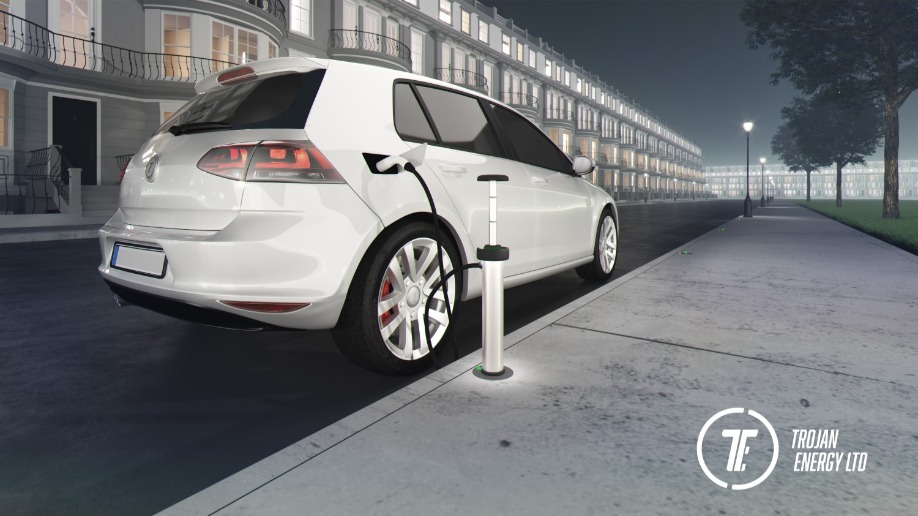
The lance is a special piece of kit that creates a temporary, slimline bollard, bringing the plug up to a comfortable height for the user to plug into with their usual charging cable. Once the car is charged, the user unplugs the lance from the connector in the street and stores it in their home or car and the street is returned to normal. Although this is an extra 3.5kg of charging equipment stowed in the car, the equipment can be plugged in within seconds without the need for apps or RFID cards to access charging or unlock. Ian Mackenzie, managing director of Trojan and one of the inventors of the system, believes the benefits will sway people on the merits of the system, “the lance is extra equipment compared to normal EV charge points, but we’ve made it so simple, quick and easy to use that we believe our customers will prefer this to normal charge points, especially when they get access to cheap smart charging rates right outside their house”.
One of the key benefits of the Trojan system is its scalability. Up to 18 charge points can be installed at once, connecting them to a single electrical cabinet that can be placed anywhere on the street, akin to the boxes used by internet providers. Installing so many at each location means that there should always be a free spot somewhere on the street, removing the need for dedicated EV charging bays. It also simplifies the installation process as the company makes just one connection to the electricity grid to supply all 18 connectors, reducing disruption to the street while installing the system.
Next steps for Trojan Energy
Innovate UK, the government funded innovation agency and OLEV have allocated £40m of funding through the Electric Vehicle Charging for Public Spaces competition to support companies like Trojan Energy in finding solutions for on-street charging. Last year the company’s STEP project was one of 18 to receive funding through Phase 1 of this competition, which helped them to demonstrate 3 key aspects of their technology.
Firstly, they proved that the concept was attractive to local councils. While the provision of EV charging is a non-statutory service for councils, meaning that they are not legally obliged to provide it, councils are coming under increased pressure to ensure it is available to allow more EVs to be adopted and improve local air quality. Secondly, focus groups demonstrated that current and prospective EV drivers would be keen to use the tech – 90% of respondents said they would like the system installed in their street. Finally, the team showed that with the uptake of EVs required to meet the government’s targets, Trojan’s system would be cost effective and represented a viable business model.
With the success of Phase 1, a consortium led by Element Energy has won a further £3million for Phase 2 of the STEP project to demonstrate Trojan’s technology in the real world. Element Energy are a strategic energy consultancy specialising in the analysis and development of low carbon energy technologies. They will be in charge of managing the project and bring with them a wealth of experience in low carbon transport and understanding of how these technologies fit into the wider context of decarbonisation across the whole energy system.
The focus of STEP Phase 2 will be to deploy 200 Trojan charge points on 12 streets across the London boroughs of Camden and Brent, giving EV drivers in the area the chance to charge up on their own street for the first time. The charge points will begin to go live starting in Spring 2021 and the trial will last up to 9 months. Exactly which streets these will be is in the process of being finalised, but residents of these boroughs can contact Trojan Energy directly (info@trojanenergyltd.com) to register their interest and receive updates as the project progresses.
The trial will provide the team with valuable data on how the technology is able to stand up to the unpredictable environment of the street. A key aspect will be proving that the system can manage water and pavement debris and allow users to charge up come rain or shine. The Trojan team are confident, having earned their spurs in the oil and gas industry working in the harsh North Sea Subsea environment. Ian Mackenzie said “Prior to going live the chargepoint design will undergo 5000 cycle endurance testing in salt mist, grit, sand and ice conditions to see if we can make further endurance improvements. We are confident that our robust and hardened design can take what’s going to be thrown at it on the street, but the on-street trial will be the real test”.
Making charging smarter
The company has also recently received funding from BEIS as part of the Beyond Off-Street Smart Meter Electric Vehicle Charging competition to add ‘smart’ functionality to their charge points. This project, SmartSTEP, will involve fitting SMETS2 smart meters to 100 of the charge points installed as part of the STEP project. These are the same smart meters being rolled out to homes and small businesses across the country which record how much electricity is used in each half hour of the day. The addition of this capability aims to reduce the impact of EV charging on the electricity grid and, ultimately make the service cheaper for customers.
The way smart meters will help achieve this is by facilitating flexible charging. If all the EVs planned for the coming decades were here today, there is a real concern the grid would not cope. This is because the grid already has to deal with peaks in demand such as when everyone gets home and turns their kettle on in the evening. If plugging in an EV is added to this evening routine, there might not be enough electricity to go around. Trojan’s system will try to avert this by allowing users to set a time they want their EV to be charged by, and a cloud-based control system will decide the when the electricity actually flows to the vehicle to meet this deadline. By automatically shifting charging to off-peak periods such as in the middle of the night, the system aims to reduce pressure on the grid and give Trojan’s users access to the cheapest electricity rates.
Once these trials are successfully completed, the company will be in a strong position to begin deploying their system at scale in cities across the UK and beyond. This should be just in time to serve the wave of EVs that are about to hit our streets and ensure that everyone can make the switch to electric, leading to cleaner cities and a greener world.
Authors: Oliver Robinson (Consultant), Sarah Clements (Senior Consultant) and Celine Cluzel (Director) from Element Energy
Element Energy is a strategic energy consultancy, specialising in the intelligent analysis of low carbon energy. We provide consultancy services across a wide range of sectors such as: low carbon transport, smart energy systems, built environment, carbon capture and storage, and hydrogen. Our key vision statement is to see net zero carbon achieved as rapidly as needed to avoid damage to human and environmental well-being.
There is a global urgency for transportation of people and goods to become sustainable. The rate of carbon emissions is higher than at any time in fossil records stretching back 66 million years to the age of the dinosaurs. We don’t really know what that will mean for us. Are we on the road to disaster? An accessible charging infrastructure is essential and maybe the U-turn we need in order to electrify transportation and reach the climate goals.

As recent as 20 years ago, we saw electric cars, buses and trucks as inferior to fuel powered vehicles, in terms of performance and driving range. Since then, battery technology has evolved. We have learned that both electric cars and even heavy electric vehicles, such as buses and trucks, can have just as good or even better performance compared to fuel powered vehicles. Sufficient reach is solved by carrying rechargeable onboard batteries. However, electrification has its challenges. With heavy batteries come major drawbacks: the weight, the cost, and the environmental impact.
But what if our roads can be electrified and digitalized, so that all kinds of electric vehicles can automatically charge their batteries while driving?
The Electric Road System (ERS) test site, EVolution Road, in Sweden is one important step in gathering knowledge around a charging infrastructure that moves us towards the adoption of fossil-free and electric vehicles – carrying minimal onboard batteries.

At the Faculty of Engineering at Lund University, professor of Industrial Electrical Engineering, Mats Alaküla, has been involved in the research and development of Electric Road Systems (ERS) for more than one decade.
– With a charging infrastructure built on overnight residential charging and fast charging stations en route, vehicles need large, heavy and expensive batteries to reach acceptable driving ranges. This is especially the case for commercial vehicles like heavy trucks and buses. It is unsustainable. We need to look for solutions that makes it possible to operate vehicles fully electrically but at the same time reduces the amount of batteries needed, says Mats Alaküla.
About the technology
The Swedish startup Elonroad is the company behind the Electric Road System used in the test and demonstration project EVolution Road. It involves a conductive rail that can be installed on top of the road or submerged into the asphalt.
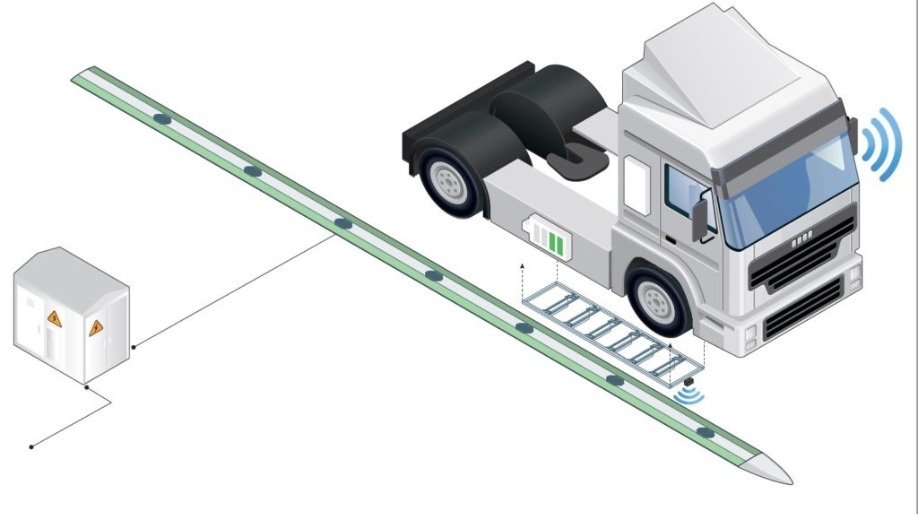
When driving, a conductive pickup under the vehicle connects to the electric rail via sliding contacts. The rail is only active when covered by the vehicle, making it safe in a city environment. The rail is powered by power stations located at the side of the road, and can deliver up to 300 kW with 97% efficiency while driving. In addition to providing propulsion, this is enough power to provide three kilometers of driving distance for every one kilometer of driving on the electric road.
Electric Road System advantages
The initial idea of electric road systems emerged around 20 years ago inspired by the benefits of continuous energy supply in trolley buses. The next generation of ERS can supply energy to almost all types of road vehicles like cars, buses and trucks and it is smart enough to distinguish the energy consumption between different vehicles, help the vehicles plan ERS charging and distribute the power selectively between different vehicles, manage billing and other services. A cost-effective expansion of ERS can be made by electrifying short distances and zones in cities and along major roads. Thanks to the electrified sections, the battery capacity can be reduced, leading to cheaper vehicles.
ERS enables reduction of battery sizes of up to 80% which reduces the weight of the vehicle as well as the negative impact on the environment and allows vehicles to carry increased payload of passengers and goods. The infrastructure is applicable on existing roads, and with the technology used in the EVolution Road project, a thin aluminum rail is applied on top of the asphalt making it exceptionally easy to install. Furthermore, the rail contains advanced technology that essentially upgrades the road to a smart and digital network, providing ample communication benefits in addition to energy supply.
Benefits to fleets of public transportation
Implementing ERS within a city for public transportation not only provides improved environmental impact in the public transportation system, but benefits for all kinds of vehicles such as cars and commercial vehicles that can make use of the same charging infrastructure as the public transportation system. This makes it a cost efficient and environmentally friendly solution for the city as a whole. In addition, modern ERS enables Smart City services, that have numerous benefits for the city and its citizens.
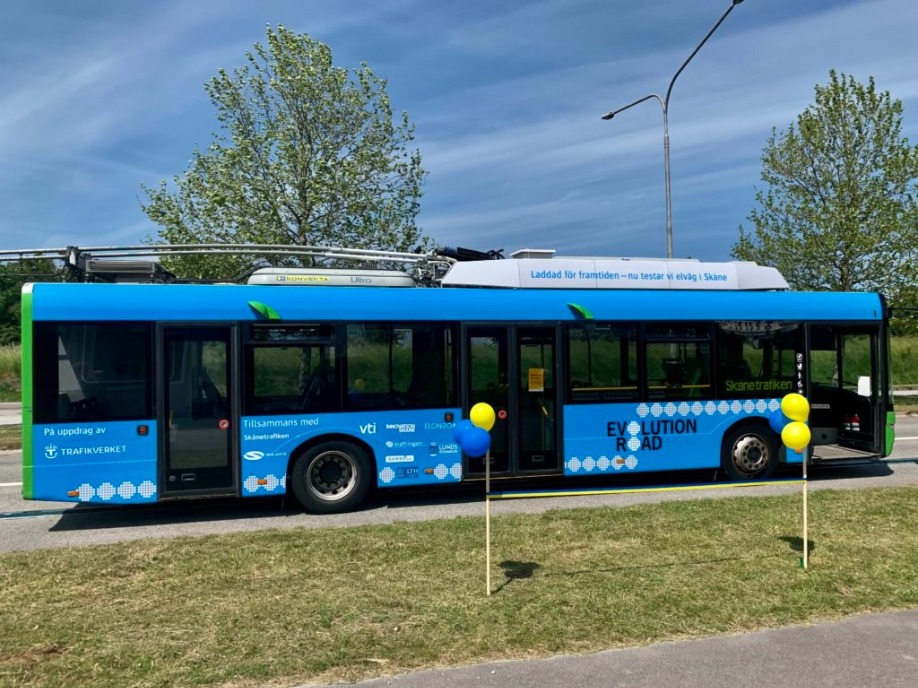
As an example, in the Swedish city of Lund, with a population of 90,000, there are ten bus lines. To electrify the fleet of buses, one solution would be to charge the buses at the end stations. At Lund University, calculations show that with ten bus lines twenty end station chargers would be needed at the approximate cost of about 7.6 million EUR (80 million SEK). In order to supply power to those ten bus lines in the city only 10% of the total route length of all bus lines needs to be covered with ERS, as the bus lines partly share the same routes. The cost of the ERS including related equipment installed on the buses, would be approximately the same as the one for end charger stations. But in the case of the end station chargers, it is exclusively the buses that use the charging infrastructure.
Can electric road systems help drive consumers to make the switch to electric vehicles?
With Electric Road Systems, EVs can have extended range and usage without large batteries, and it allows smaller and cheaper EVs to be much more attractive for consumers.
– Why should we stop to recharge when it’s not needed – and more importantly – carry the weight of heavy batteries as we drive? With ERS you have seamless charging, that is, you simply charge while you drive, or even while you’re parked. You don’t need to stop to recharge and you don’t have to worry about range anxiety, says Karin Ebbinghaus, CEO of Elonroad AB and partner in the Swedish ERS project.
Sweden is pioneering Electric Road Systems
Sweden in one of the pioneering countries when it comes to ERS with four different ERS test sites on public roads. The next step on the Swedish ERS roadmap is to build a 30-kilometer pilot, the country’s first permanent ERS. The projects are funded by the Swedish Transport Administration as one of the solutions to the Government’s goals to reduce the emissions from domestic transportation by 70 percent by 2030.
About Elonroad
Our vision is to electrify the entire transport sector and make fossil fuel a thing of the past. With clean energy from the sun, wind and sea in an emerging charging infrastructure that is accessible for everyone, and with gradually more and more self-driving vehicles shared in a smart way, drastically reduced CO2 emissions will follow.
Sitting in the backseat of a cab in Paris, Daniel started chatting with his driver, Jean. The latter had recently bought what he thought was a fantastic car: beautiful and comfortable. However, that car had one irritating thing: you could not properly fix the phone to the cockpit, and this was all the more annoying since Jean would often need to do this for navigation purposes. Eventually, for that reason and other smaller things, Jean sold his car. What’s worse, the carmaker would never hear about this defect and keep on producing vehicles in the exact same way.
How many times have you thought about how companies could improve their products we use in our everyday life? A lot, probably.
But how many times have we actually taken the time to pick up the phone or fill in an online form to report the faults of these products? Much less, correct?
User experience is a crucial aspect of the strategy of a company in order to have loyal customers. Can a company build a sustainable business if their clients only use their services once? Basing ourselves on the aforementioned example, carmakers, in particular, need to focus on their feedback management processes. And indeed, it can result in being a long and tedious process: collecting the information in various channels (social media, customer satisfaction forms, etc.), classifying it (customer service, vehicle performance, etc.), analyzing it, before finally implementing concrete actions.
After that taxi trip in Paris and based on his conversation with Jean, Daniel Ritter started to think of a simple process to collect and analyze the feedback of all the Jeans in the world. This way, the Product teams of every automotive company would be able to know exactly not only what gets on the nerves of their customers while using their vehicles but also what makes them fall in love with them. And this is how the concept of Better World came to life.

Better World is a French startup that offers an end-to-end feedback management solution, specifically dedicated to the automotive sector. The feedback is collected from data sources adapted to the industry, including a leading-edge in-car vocal feedback data source.
The Natural Language Processing (NLP) algorithms are tailored to the automotive-related language. As a result, Better World's solution is able to detect automotive products and services with accuracy (e.g. the precise generation of a given car), allowing competitive benchmarking.
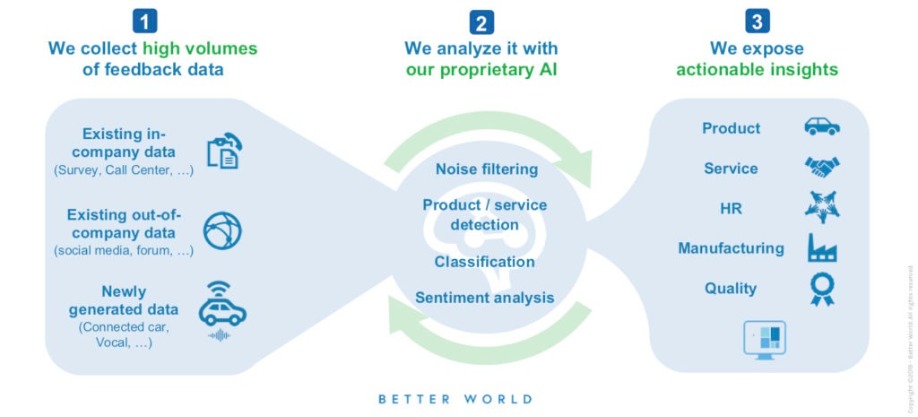
The data collected allow automotive actors to focus on different areas of improvement:
● Product development: allowing to define the specifications of new products.
● Manufacturing: improving the efficiency of factories and leveraging the insights of operators.
● Service: adjusting to the customers’ expectations.
● Quality: detecting and launching corrective actions earlier and faster.
Better World works with major European and Japanese carmakers and helps them to monitor customer satisfaction in early phases after launch, to prepare mid-life reviews, and to detect quality incidents very early to reduce warranty and recall costs.
The startup developed a wide-leading automotive vocal feedback analytics system. Such an innovation got them selected to take part of the IMPACT Connected Car acceleration program, an initiative supporting innovative startups and SMEs in the automotive industry. Last year, during the IMPACT Connected Car Pioneer Award, Better World was awarded as the best European startup in the automotive sector!
“I have had a really great experience with IMPACT Connected Car, especially when considering the coaching from renowned automotive experts that allowed us to be even more focused on our offer. Also, the program gave us visibility, which helped us in our commercial development. What’s more, you receive funding and the ability to network with other connected car companies.” - said Daniel Ritter, CEO of Better World.
The current global pandemic-situation affected all sectors, and the automotive one was no exception. The Better World team needed to have a fully remote working environment during the peak of Covid-19 in France. They took advantage of the activity decrease to re-allocate some time to the development of a new version of their product.
Besides, the company made a breakthrough in the medical sector. Better World decided to build a scalable model for other industries, healthcare included: the purpose is to analyze patients' feedback with respect to their in-hospital experience.
Aligning the working approaches with corporate partners and clients has been one important challenge the startup has been facing.
“A first challenge was the speed of decision-making. We overcame this challenge by proposing risk-free offers, with "pilot" periods with no commitment. The second challenge was the fear of competition between internal data science teams and startup teams. We overcame this challenge by building a clear collaborative way of working building on mutual strengths.”
“The automotive sector is undergoing massive changes, especially towards more electrification, more autonomy, more sharing and more connectivity. This implies that carmakers urgently need to define where they want to go, in this fast-changing context. We believe that it is critical to leverage the input of users in that process, which is precisely what Better World is enabling.”
According to Daniel, the future of automotive customer feedback collection will be vocal and take place inside cars leading to the end of lengthy surveys that are filled in at home, online or on paper. Imagine your car could just ask for your feedback (if you agreed to it upfront) while you are stuck in a traffic jam.
INFO ABOUT THE AUTHOR:
Liliya Pislar, the author of the article, works for FundingBox as a Marketing Specialist.
Better World is a French startup that specializes in end-to-end feedback management solutions, specifically dedicated to the automotive sector. The company was selected to take part in IMPACT Connected Car, a European smart mobility program coordinated by FundingBox.
As the transition towards connected and autonomous vehicles (CAVs) gains pace, the issue of automotive cybersecurity has quickly risen up the ranks as a critical priority for industry and the government alike. But with so many factors to consider, including not just the development of the technology needed to offer real-time responsiveness to threats, but the correct implementation of standards, rules and best practice guidelines, the journey towards a robust, unified approach to CAV security is one which will hinge on innovation and cross-industry collaboration.
Here, Anthony Martin, Head of Vehicle Resilience Technologies at HORIBA MIRA talks about the important role that a pioneering new project, ResiCAV has played in helping define the roadmap for automotive cybersecurity – including the urgent call for a national programme.
It is well documented that this modern age of the Internet of Things (IoT), in which almost every aspect of daily life is connected, comes with a risk. Indeed, as more processes become digital, and the physical and virtual worlds merge to offer benefits that include optimised efficiencies and convenience, the downside is an increase in opportunities for cyber-attacks.
Unsurprisingly then, with the UK government having asserted ambitions to be a global leader in CAV deployment and manufacturers continuing to make major breakthroughs in developing next generation vehicles, one pressing concern has quickly risen to the forefront – how will cybersecurity policy operate in the penetrable future world of connected vehicles?
The reality is that the collective government and industry response to this will be incredibly important in terms of ensuring a safe and seamless transition to CAV deployment.
After all, the cyber threat facing CAVs is potentially a very serious one. As with most modern computer technologies, tomorrow’s connected vehicles will incorporate many different connection mechanisms to support the exchange of data between vehicles, people and infrastructure. This reliance on constant connectivity throughout the lifespan of the vehicle, exacerbates risk by presenting multiple opportunities for a hacker to implement a successful attack.
The resulting consequences are far-reaching. In addition to implications for users in terms of compromised privacy, fraudulent financial transactions and loss of functionality, there are serious safety risks in the potential for hackers to cause major road accidents or congestion.
Also aligned to this is the issue of public trust, as consumers become increasingly wary of the threat of cyber-crime. Two in five (43%) have admitted they’d stop associating with businesses that suffer data breaches.1 Thus, failure to achieve sufficient public trust in the safe and secure operation of CAVs and the associated infrastructure could affect the huge socioeconomic benefits afforded by the future mobility vision.
The good news is that amid growing concern around current automotive cybersecurity threats, recent years have seen the industry and government break major new ground in understanding the role of future automotive cybersecurity, driven by a number of major, government-funded collaborative research and development (R&D) projects.
Breaking New Ground
A great example is ResiCAV; part of a programme of seven collaborative projects bringing together cross-sector industrial, academic and government expertise from a range of key sectors in order to ascertain how the mobility industry should respond to emerging cybersecurity threats.
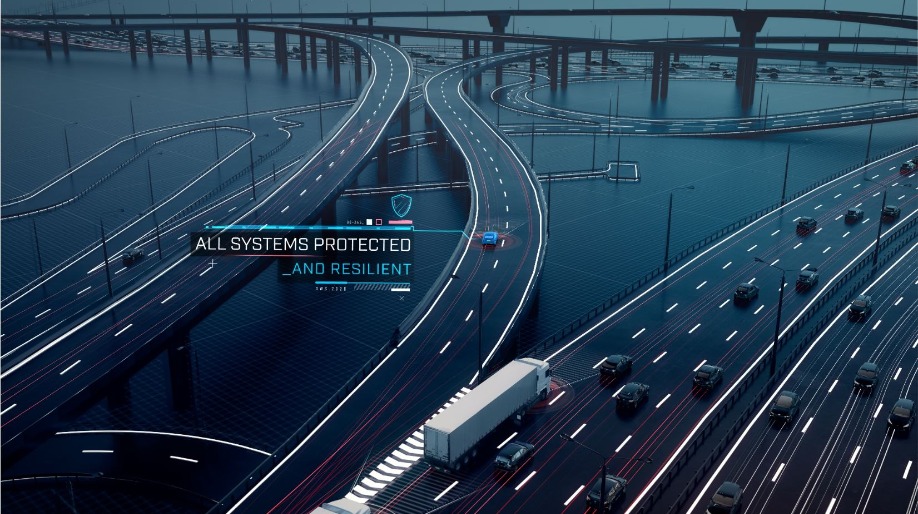
Supported by Zenzic and part-funded by the Centre for Connected and Autonomous Vehicles (CCAV) and Innovate UK, the ResiCAV project saw numerous leading research bodies and industry giants, including HORIBA MIRA, come together in a three-month study designed to explore the feasibility of creating a UK Cybersecurity ‘Centre of Excellence’ to address emerging cybersecurity threats across the mobility eco-system.
The resulting progressive research has not only successfully demonstrated the commercial viability of the creation of a UK Road Transport Centre of Excellence for Cybersecurity Resilience (CYB-R) – but asserted its very pressing need.
As part of the project, HORIBA MIRA took the lead role in formulating the vision for the Centre. For us, this vision involves bringing together the very best UK expertise to create an ecosystem of specialist services to include research, engineering, test, simulation and certification in road transport cybersecurity and resilient mobility, along with a closely-related education and training initiative. Hereby, the aim is to leverage existing capabilities to rapidly place the UK at the forefront of developing and providing cybersecurity solutions for the global mobility revolution.
In terms of achieving this progressive vision, our detailed report in this remit sets out a roadmap of six equally important recommendations that help set the direction for future policy.
First, it identifies the importance of bringing together a full range of world-class facilities, based on a linked cybersecurity testbed ecosystem (CLUST-R) that will integrate newly defined and existing UK testbeds. This must be supported by a broad range of relevant skills and capabilities in terms of different CAV and mobility technologies and their cybersecurity aspects. In an industry susceptible to an escalating skills gap, we believe this will rely heavily on attracting new talent and honing the next generation through dedicated learning, progression and development.
Equally important, we recommend that the CYB-R Centre must also act as the focus for a national capability to ensure the cybersecurity resilience of the UK’s associated V2X infrastructure, as well as providing an associated CYB-R Certification Centre. Aligned to this, the facility must also lead UK participation in relevant international standards and regulatory activity, including informing future government policy on cybersecurity for CAV and the wider mobility ecosystem.
As cybersecurity is a constantly evolving problem that tracks the developments in technology, it is imperative that CYB-R is closely integrated with a collaborative R&D environment with funding streams for the development and validation of future cybersecurity resilience methodologies.
Finally, updates to UK criminal legislation that make better provision for ethical and responsible cybersecurity research activities, will be essential to enable the lawful operation of all CYB-R engineering and research facilities to full effect.
Of course, this multi-faceted future vision is an incredibly complex one that HORIBA MIRA was proud to lead, but the end result would be a world-leading, truly one-of-its-kind Centre of Excellence which would accelerate development of cybersecurity capabilities for CAVs and their infrastructure and will attract investment, build international reputation and develop UK intellectual capital – on a world stage.
A Driving Force
While many other government-funded initiatives have made solid automotive cybersecurity related recommendations, ResiCAV has uniquely proposed guidelines for protective operational monitoring technologies and services.
As a result of the extensive insights revealed during the work, recommendations set out by HORIBA MIRA have not only put forward a compelling case for the urgent delivery of a UK Centre of Excellence – but have also outlined the practical approach to its delivery.
Amid the escalating speed of CAV development, which continues to see more connected vehicles on the road, it becomes increasingly important that the UK leads the way in its according cybersecurity capabilities. Indeed, it may be a complex and vast task, but it is a fundamental one which, starting with the development of a national Centre of Excellence, will see the UK establish itself as the driving force behind automotive cybersecurity in the global race towards future mobility.
To read the full ResiCAV report, visit: www.horiba-mira.com/Vehicle-Resilience/automotive-cybersecurity/resicav-cyb-r/
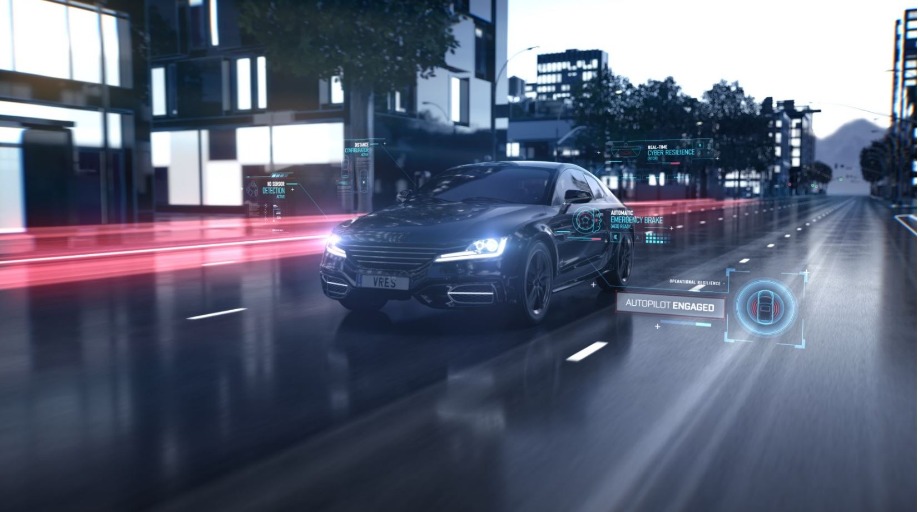
The most important requirement for running an electric car is electricity, and it's also the biggest problem. The deployment raises several questions. The efficient storage of energy for electromobility is the greatest challenge in the transport sector. In the future, fuel cells using methanol or hydrogen will mainly be used as an energy carrier, and in some areas the battery will also help drive an electric car. Each of them needs their own specifications, but in the end, they all deliver the performance an electric car needs. With the exception of the type of power supply, all electric cars are identical in their basic construction. The use of this fact to develop a platform that can be equipped with different power suppliers, such as a methanol fuel cell or a hydrogen fuel cell or with a battery, could mean an enormous boost for electric mobility. Such a ‘flexible energy platform’-strategy could help to solve a lot of problems.
In the beginning, it was useful to focus on one type of power source, gain experience with specific issues, and simplify setup. On the other hand, it would not make sense for small manufacturers with a specific target group to build a flexible platform that is suitable for different types of energy sources, as this would only increase their costs. Still, now that advances have been made in the development of electric cars, does it make sense and is it economical to develop a separate platform for each type of power source in general? There are several points why a flexible energy platform should be developed. In many regions and countries, the new technologies, e.g. for methanol and hydrogen, are not being introduced because there are not enough electric cars available for this type of energy source and, with it, the development of the infrastructure is therefore also suffering as a result. With the strategy of flexible energy supply platforms, automobile manufacturers can react quickly to new situations in regional markets and offer e-cars that are operated with the right power supply. This, on the other hand, would motivate regions and countries to invest in an economic infrastructure for new technologies, since the demand will exist. Another point for the flexible energy platform strategy is that developing an additional platform for each individual energy source is too expensive. The development of the flexible energy platform may cost a little more than a power platform that can only be equipped with one type of power supply. However, this problem is solved by increasing the number of build units due to the flexibility, which reduces the cost of each individual car and the cost of the entire development.
The current focus on battery-powered e-cars is determined by ideologically motivated groups that currently have a major impact on the public media and news sectors. If you build some windmills and charge your electric car's battery, you will get no closer to your goal of reducing carbon dioxide emissions. There is a lot more to consider than just charging a battery. Most of the revenue from battery-powered e-cars is only possible thanks to the financial support from governments for the purchase of such a car and the low prices for green electricity through tax support for green electricity. How many countries can actually afford a large fleet of e-cars and how much money can they provide for them? This will set a limit for the big electric car breakthrough worldwide, as only rich countries are capable of such luxury environmental policies. Would that be enough? A broader base of energy sources for e-cars is needed as it is important to reduce real costs without subsidies. If the electric car is to be a worldwide success, it is important that the buyer can afford the actual price without an ideologically disrupted contribution, otherwise it will be a financial problem for most of the countries in the future. The flexible energy platform strategy will form the basis for a low-cost and substantial development of the e-car sector independent of subsidies. Every country and region have its own preferences in the energy sector and the associated costs. The car manufacturer can serve it with a flexible energized e-car offer.
Ultimately, it's all about money, and developing flexible e-car platforms for different energy carrier offers many strategic and financial benefits. The standard car manufacturer should be able to supply any type of electric car equipped with the power supply of the region it is being exported to in order to reach a large number of people who want to buy an electric car that can also be afforded. This could also be good for the environment as electric cars with the right power supply and energy source are the most energy efficient way to drive. The goal is to appeal to different groups that uses more than one different type of energy source, to sell e-cars to destinations with different economic performance, or to sell a large number of your e-cars, as it is more efficient to develop a flexible energy platform, than developing a new platform for every energy carrier. For the successful establishment of electromobility, we need all three types of power sources and at reasonable prices. The flexible energy platform strategy also simplifies parts of the automotive industry, since logistics are simplified, performance is accelerated and the flexibility of changes is increased. It is also very important that these thoughts apply not only to electric cars, but also to electric buses, trucks and trains. In the area of heavy mobility in particular, other energy sources such as methanol or hydrogen are important in order to invent an environmentally friendly and economical use of electric mobility.
In addition, all e-car manufacturers should form an alliance to set standards for power sources and platforms so that suppliers in the fuel cell and battery sector can also produce higher quantities and thus lower prices. If each competitor develops their own standards, everyone will lose money with them. If standards are set, all competitors can save and make money.
By Hans Rodestock - CEO at HR-FuelCell
More than 18 months on from its official opening, Peter Stoker, Chief Engineer – Connected and Autonomous Vehicle at Millbrook, lifts the lid on the ground-breaking work taking place on its AutoAir 5G test bed for transport.
At the start of last year, Millbrook Proving Ground opened its 5G testbed for transport, the culmination of many months’ hard work by the AutoAir consortium. The UK’s first – and to-date only – private, fully operational high-speed mobile data network specifically for mobility,it was installed to support the development, testing and validation of connected and self-driving vehicles.
Since it opened, it has supported developers of connected and autonomous vehicles (CAVs) and associated technologies, and has helped to position the UK automotive industry as a leader in global CAV and driverless vehicle technology development.
Before we look at the use cases being explored and the impact that AutoAir is already having on future technology and transport infrastructure, it is important to first understand the origins of the testbed.
In 2017, the UK government Department of Digital, Culture, Media and Sport called for the establishment of 5G vertical sector testbeds and trials. The AutoAir consortium, led by Airspan, which brings together leading lights from the mobile communications and transport sectors, was formed in response to this call to action.
The testbed is the only accelerated development programme for 5G technology based on small cells that operate on a neutral host. This makes it a truly unique set up. It allows multiple public and private mobile network operators (MNOs) to simultaneously use the same infrastructure using network slicing, which can radically improve the economics for 5G networks.
As part of the project, the consortium set up 60GHz mmWave mesh radio between small cell sites to connect them to the core network (“backhaul”). This has enabled the consortium to compare this with the costs of deploying fibre. The testbed itself consists of 89 radios, covering 2.3, 3.5, 3.7GHz 4G and 5G spectrum, 60GHz mmWave mesh and 70GHz high-speed vehicle-to-infrastructure links. 59 masts were fitted around Millbrook, linked by 30km of power lines and fibre cabling.
The AutoAir testbed has already yielded significant insight. For instance, it’s provided clarity as to how MNOs, vehicle manufacturers, governments and transport operators could harness neutrally hosted 5G and mmWave spectrum networks in the future for a more cost-effective and connected mobility.
AutoAir’s innovative proposition is a wholesale access neutral host hyper-dense small cell deployment model for transport corridors. It provides a single, shared infrastructure set across multiple MNOs. This makes mobile services on transport corridors more attractive for mobile operators and end users, unlocking a multitude of possibilities.
For example, in the UK, all four existing MNOs would be able to share the same physical network. In addition, other organisations, such as emergency services, road maintenance firms and vehicle manufacturers would be able to run their own private networks on the same shared infrastructure at a fraction of the cost of deploying their own physical networks.
It should be evident that the fledgling stages of the AutoAir testbed were more concerned with transport infrastructure. The reality, though, is that the AutoAir testbed has only really begun to scratch the surface of how 5G technology might be harnessed more widely in the automotive sector.
That is why it is exciting, and hugely important, that the AutoAir testbed is now being operated on a commercial basis. This gives CAV developers the ability to really push the network to its limits and make significant advances in their technology.
Millbrook’s unique environment provides an unrivalled location in which to do this. For instance, developers can simulate weak and strong cell signals and understand the impact of hills and other terrain in a single location, while having access to all data generated during testing. They can also create virtual events using augmented and virtual reality for vehicles on its test tracks, allowing them to test complex scenarios that simply would not be practical, or safe, on public roads.
As a result, a variety of organisations, working on a myriad of uses-cases, are already exploring the capabilities of the 5G network. One particularly interesting, and potentially lifesaving, trial that was successfully run courtesy of AutoAir was the “Smart Ambulance” trial with the East of England NHS.
This pioneering project involved equipping a standard ambulance with state-of-the-art devices and connectivity to create a Smart Ambulance that simulated 5G connectivity. The ambulance was transformed into a unique remote consultation room, able to relay a live video stream to a remote team – potentially saving the time needed to save a life.
And that’s just one example of how the super-fast data transfer afforded by 5G might shape our futures on the road.
Indeed, the 5G testbed at Millbrook is also enabling CAV developers to expedite the testing and development of new infotainment and multimedia technologies. As was demonstrated with the Smart Ambulance trial, 5G facilitates vehicle-to-vehicle (or vehicle-to-remote location) communication in real-time. But that’s just the tip of the iceberg. This new level of connectivity enables over-the-air software updates in real-time, as well as delay-free video and music streaming, real-time map downloads and more.
Looking beyond road transport, one area explored is that of high-speed rail. Trials were done on the mmWave network, installed by Blu Wireless as part of Autoair, with a view to improving the passenger experience. How often has connectivity on the rail network delayed communication, broken voice calls, and interrupted data? The challenge was to see how effective the deployment of mmWave trackside could be. Using the High-Speed Circuit at Millbrook for the work, Blu Wireless, in partnership with McLaren Applied fitted a vehicle with a train antenna system and drove at up to 160mph, whilst streaming data to and from the vehicle. The results were impressive – a steady 1.6GBps, peaking at 3GBps. Work continues to evolve, now looking at infrastructure installations in remote areas – where there may not be ready access to power and fibre.
This new age of connectivity and autonomy is not without its pitfalls. One of the biggest areas of concern in relation to connected and autonomous cars has always been cyber security. With enormous amounts of data being transferred in real-time from vehicle to vehicle, vehicle to infrastructure and beyond, there is little wonder there are concerns over hacking and privacy.
The UK Government in the form of the Centre for Connected and Autonomous Vehicles ran a feasibility study competition in 2019/20, looking at the threats to vehicle networks. As a direct result of the Autoair testbed, Millbrook was a partner in a consortium with industry experts Cisco, Telefonica and Warwick Manufacturing Group, looking at the challenges, mitigations and regulatory futures in cyber. This could well pave the way to the creation of bespoke CAV Cyber test facilities in the future, equipping the UK at the forefront of this important area. There is, however, much more work to be done.
The achievements and findings of the AutoAir testbed so far are fundamental steps towards enabling key 5G use cases for CAVs and other transport solutions. The project is also a prime example of why working at Millbrook is so rewarding. Having the opportunity to be ‘in the room’ when cutting-edge technology solutions that could change the future of mobility are being devised and tested is a real privilege. While the AutoAir testbed is, in every respect, a collaborative team effort, a certain amount of pride that it’s our Bedfordshire proving ground that is home to the project.
A final point: the AutoAir testbed will not be a snapshot in time in the development of CAVs, the associated technology and the wider infrastructure. Instead, the testbed will be updated with the latest technology as it nears market reality, and is set to serve the industry as a national standard for many years to come.

Generally, if you were to ask someone to define “transport” or “poverty” you would receive a reasonably accurate answer. But put the two terms together and you have something that compounds some of the world’s biggest issues and yet isn’t often referred to.
By Natalie Dowsett - Head of Business Development for OX
In the past 30 years, the number of people living in extreme poverty has been reduced by 1.1 billion. Although this progress has been made in tackling world poverty, the Sustainable Development Goal to eradicate extreme poverty by 2030 does not look achievable on the current path. There have been many factors contributing to this but infrastructure, or lack of, is one of the key barriers to further progress.
However, off-grid solar power solutions have been able to extend power to millions of Africans that had no access to electricity, essentially bypassing the need for a traditional developed world power infrastructure. The infrastructure in telecommunications has also made similar progress by bypassing traditional land lines straight to mobile phone usage.
What still falls far behind though, due to the vast scope of the issue, is the transport infrastructure. According to the African Development Bank the dominant mode of transportation in Africa is roads, making up for 90 percent of all passenger and freight transportation, and they are the only access route for many rural locations. Yet according to a recent BBC article, only “43% of the roads in Africa are paved. And 30% of all paved roads on the continent are in one country: South Africa”. The article also references the transport infrastructure as a key challenge in achieving the African Union’s Agenda 2063 vision which outlines the 50-year aspirations of the continent. Ultimately the poor transport infrastructure and in particular the poor roads have stalled the economic growth in a number of African countries.
Is there a way to bypass traditional approaches to transport infrastructure, in a similar way to power and telecommunications? And what would this mean for those living in extreme poverty?
Let’s explore an example...
According to the World Bank more than half of people living in extreme poverty live in Sub-Saharan Africa. The majority of the global poor live in rural areas, are poorly educated, employed in the agricultural sector, and under 18 years of age. More than 70 percent of people living in rural Africa are estimated to have been left unconnected due to missing transport infrastructure and systems. If we use this information to consider an East African, young, rural farmer with no access to motorised transport as an example of a person living in extreme poverty, we can develop a story as the basis of this article.
With no access to transport any produce that the farmer can yield from his land can then only be sold to any person or market within walking distance, which could be a substantial distance with a pushcart. The quality of the produce by the time it has travelled for hours in the sun has diminished. The amount of produce that can be transported manually is minimal. Therefore, the farmer is limited to selling a minimal amount of lower quality produce at a market they can access. The land which the farmer farms is irrigated manually which is not suitable or efficient for large areas.
So, looking at this picture of poverty what happens if transport was made more accessible to this farmer? Firstly, any produce produced can get to a market, maybe multiple markets or larger markets further away, in a better condition because it has got there faster. More produce can be moved too, perhaps ten times more produce of better quality. Instantly we can see how the farmer’s income could be increased even on a conservative measure. The farmer’s time is more productive too, as instead of the hours spent walking to the market, he has been able to get to a market and back again. With this increase in income, perhaps the farmer could invest in a solar powered irrigation system for his land to maximise the yield and in turn generate more income. This could potentially lead to employment for somebody else to help the farmer with his increased yield. It’s relatively easy to see how the impact could continue to benefit families and communities and wider economy. All from providing one farmer access to transport.
This example gives one example of what transport poverty looks like and the impact of relieving it. Transport poverty has many elements, ranging from infrastructure to vehicles. The problem is clear, and the solution is less so, but what seems to be obvious is that adopting current developed world solutions won’t work.
The majority of vehicles available in Africa are imported and are designed for different purposes and conditions. Giving a rural farmer access to transport that struggles to navigate unpaved and poor roads won’t help them at all. Most of these vehicles are also adding to harmful levels of pollution from engines that wouldn’t be deemed fit enough to drive on roads in developed countries. So, to bypass the issue of poor roads and stop the pollution - provide green transport that has been specifically developed for these conditions.
At OX we believe there is an alternative, better way involving alternatives to the traditional means of owning transport by using shared mobility, pay-as-you-go or other collaborative ways of thinking. By avoiding going down the same path as the developed world, the developing world could leapfrog out-of-date and inefficient solutions and create a new, transport rich environment without the downsides of pollution and debt.
This rural farmer is just one example of the positive impact effective transport can have on poverty. At an individual level, if someone has access to fit-for-purpose transport then they have access to opportunity. That opportunity can come in many forms, including access to education, healthcare, other communities, produce and markets to name just a few. If someone doesn’t have access to transport they are limited in their opportunity. If someone living in extreme poverty doesn’t have access to transport then it is almost, if not completely, impossible to leave extreme poverty behind.
The OX is on a journey to deliver opportunities, create an ecosystem through enhancing existing services and to bring communities together to achieve a better, fairer way forward. In this series of articles, we want to demonstrate how the OX truck combined with a transport-as-a-service model will tackle the challenge that affects billions of people in the world; transport poverty.
Information about the company:
OX, was founded by UK-based charity, The Norman Trust, with the vision to bring affordable transport to those that need it the most. Prof. Gordon Murray was commissioned to design the unique OX truck which is the only utility vehicle designed for the developing world. The OX truck is all-terrain, high-capacity, flat-pack and low cost - all requirements for a vehicle suitable for the conditions in the developing countries it is intended for. There are currently four prototypes built that have been tested in India, Spain and the UK.
The OX truck is at the heart of the innovative ‘Transport-as-a-Service’ strategy OX has developed to enable accessible and affordable transport which is an ecosystem consisting of both physical and digital services.
Our strategy is to deliver affordable transport in emerging markets, driving a self-reinforcing cycle of economic growth and social impact.
The instant we began to practice social distancing, the way we consume transportation shifted. Can you remember your last time ride sharing? And if it was recent, then the answer is likely to be, “vividly.” Yet shared mobility has been experiencing a resurgence. How? The answer is that there are many forms of shared mobility, and in today’s environment, the need for one in particular, carsharing, is stronger than ever. But this time with a twist. People are now interested in keeping a vehicle for longer periods: a week, a month, or even more.
Before the pandemic, carsharing, especially one-way carsharing, was just one of many options you’d consider when getting around town. You could take a car share to your destination, park, and end the rental, and afterwards, you would use it or another nearby car for the next part of your journey. If, by chance, no cars were readily available, you had peace of mind knowing that you could always easily hail a ride or perhaps take public transit. Now in a pandemic, considering the risks of shared transportation, especially sharing space actively with others, has become a serious factor in how we move about our cities. And it has given many people pause before they choose to venture out.
According to an IBM study, 20 percent of people who used to take public transportation said they would no longer take it until the pandemic was over. Another 20 percent said they plan to reduce their public transportation usage. Ridesharing rides are down 75% while other forms of shared transportation have rebounded to their pre-COVID levels. So how is the market addressing this growing customer segment of former rideshare and transit customers? The response has been to create short term rental plans that let customers keep cars for longer.

GIG Car Share in the Bay Area and in Seattle has added multi-day rates to their fleet. Now you’re able to rent a hybrid or all-electric vehicle for 3 days, 5 days, a week, and for the electric Gig even for a month! Effectively what this means is that in the three minutes it takes to download an app and go through the signup process, you have just secured the right to use a car with insurance, fuel, maintenance, and even parking included in one fixed price, plus you also have the right to return it or extend it as needed. If you’ve ever stood in line at a rental counter or sat in a leasing office, when has acquiring a car ever been this easy? Leasing commits you to multiple years, requires you to carry your own insurance, and may still require you to pay your own maintenance. Forget about parking. Or rather don’t because that’s on you. As an alternative to all of this, the simplicity of carsharing has now become a preferred method for people who don’t wish to share a car. Well, at least until they’re done with it.

In Madrid and Paris, the Zity carsharing service responded to the demand for people who now want to use one of their all-electric ZOE vehicles by adding 1, 2, and 3 day plans in addition to the rental by the minute option.
And the new KINTO Share service in Stockholm was designed with the option for longer-term use in mind. Customers can go from initial signup to rental in minutes, whether choosing to use a car for a quick trip or over the span of months
You might wonder as this demand grows for short term vehicle access with the simplicity of carsharing and dependability of a dedicated vehicle, what is the traditional automotive industry also doing to address this opportunity? Subscriptions!
Subscriptions have also been quietly making a comeback. But unlike first generation subscriptions where the value proposition was more about vanity and luxury vehicle swapping, the 2020 value proposition is about simply and affordably getting people into a vehicle with no long term commitment and little overhead of insurance and maintenance. It’s similar to the car-as-a-service concept where one payment with a reduced cost of entry gets the person the right to drive a vehicle for as long as they need one—without obligation to keep it any longer than that. For many, this is a very attractive option over multi-year lease commitments or owning a vehicle, especially with economic uncertainty and until an effective vaccine for COVID-19 is widely available.
Looking further forward, once people experience the flexibility and simplicity of this way of securing their own transportation, going back to the old ways of sitting in a dealership and filling out forms, scheduling maintenance, and hunting for insurance will all seem like an antiquated process. In other words, this isn’t just a short-term pandemic opportunity. It will become the new expected normal and the baseline in the automotive industry.
Today, so many of us are navigating so many serious concerns and uncertainties. It’s a small silver lining but a silver lining nonetheless that the future of vehicle usership doesn’t need to be among them.
Author: Mark Thomas, VP of Alliances and Marketing, Ridecell
Currently, the conventional mechanical LiDAR system, limited by their big size, high cost, and short of capability in identifying obstacles from the point clouds, is barely able to meet the safety requirements of commercial mass-produced autonomous vehicles. For the environment perception of autonomous driving, the sensor hardware only collects data, thus AI perception algorithms for LiDAR point cloud data analysis are needed for driving decision making. Therefore, a new generation of high-precision 3D environment sensing solid-state smart LiDAR sensor is required to fulfill the industry’s challenges.
RoboSense “RS-LiDAR-M1” is the world’s first and smallest MEMS Smart LiDAR Sensor that incorporates sensor hardware, AI perception algorithms, and IC chipsets all in one, with the performance equal to 125 laser beams, and the horizontal and vertical resolution of 0.2°, the field of view of 120°×25°, and the ranging capability of 150m@10%. It meets almost all automotive-grade requirements on a LiDAR, including intelligence, low cost, robustness, simplified structure and small size, vehicle body design friendliness, and algorithm processed semantic-level perception results output.

The smart LiDAR sensor's built-in AI perception algorithms transform the conventional 3D LiDAR sensors as solely information collectors to full data analysis and comprehension system, outputting semantic-level structured environment information in real-time ready to be used for autonomous vehicle's decision making. Nevertheless, it can reduce the processing load of the vehicle's ECU, and save the extra cost and R&D pressure for OEMs to develop their own AI Algorithms.
Apart from all-in-one MEMS solid-state smart LiDAR sensor, RoboSense also provides high performance one-stop smart LiDAR solution RS-Fusion-P5 for RoboTaxi. A fusion of best-in-class 128 laser beams LiDAR RS-Ruby and blind-spot detection LiDAR RS-Bpearl, the RS-Fusion-P5 solution is able to reach a detection range of 200m, and high-precision resolution of 0.1° with full sensing coverage, which can detect all objects with visible level details, such as lane lines, passenger cars, vans, trucks, bike, pedestrian, etc.
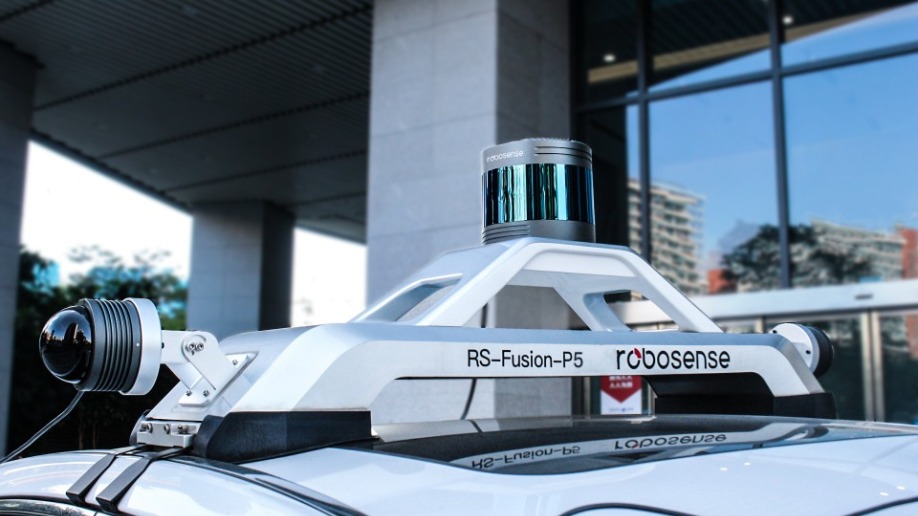
The RS-Fusion-P5 adds AI perception algorithm "RS-LiDAR-Algorithms" to empower L4&L5 autonomous vehicles with structured semantic-level perception functions in real time, including ground detection, obstacles detection & classification & tracking, attention object detection, free space detection, etc. It gives outstanding performance in various complex Chinese road conditions.

To date, RoboSense has formed its unique product strategy of developing automotive and industrial LiDARs combined with AI processing algorithms to provide one-stop perception system solutions for various autonomous driving applications.
RoboSense LiDAR systems have been widely applied in the future mobility, including autonomous driving passenger cars, RoboTaxi, RoboTruck, automated logistics vehicles, autonomous buses and intelligent road by domestic and international autonomous driving technology companies, OEMs, and Tier1 suppliers. Our partners include the world’s major autonomous driving technology companies, OEMs, and Tier 1s. Our strategic partners and investors include Alibaba’s Cainiao Network, SAIC, and BAIC. We also have deep cooperation with some top OEMs and Tier 1 companies, such as China’s FAW (First Automobile Works), the world’s leading automaker, who will use RoboSense RS-LiDAR-M1 LiDAR in their proprietary next-generation autonomous driving system.
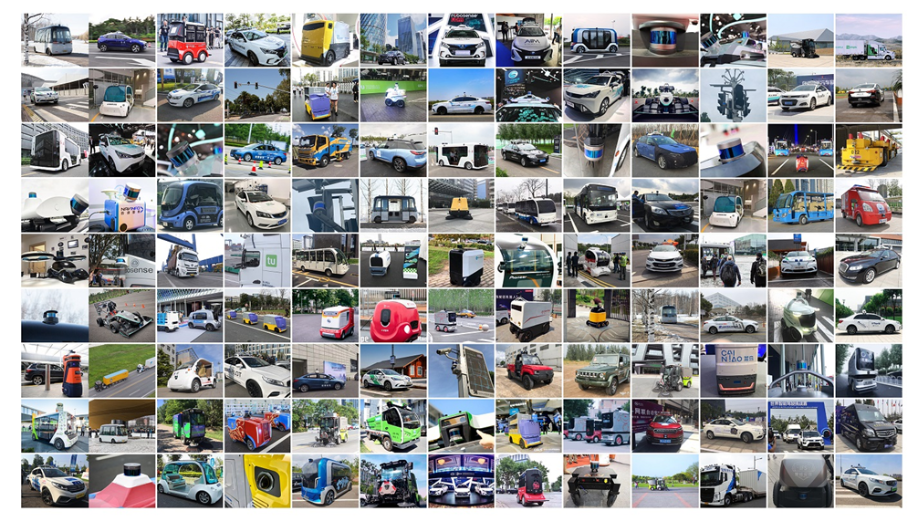
About RoboSense
Founded in 2014, RoboSense (Suteng Innovation Technology Co., Ltd.) is the leading provider of Smart LiDAR Sensor Systems incorporating LiDAR sensors, AI algorithms and IC chipsets, that transform conventional 3D LiDAR sensors to full data analysis and comprehension systems. The company's mission is to possess outstanding hardware and artificial intelligence capabilities to provide smart solutions that enable robots (including vehicles) to have perception capability more superior to humans.
Attracted an all-star team from leading corporations and institutions around the world,there are 500+ employees in 6 global locations-Shenzhen, Beijing, Shanghai, Suzhou, Stuttgart, and Silicon Valley to support RoboSense's fast-growing in innovation and development. Until 2019, RoboSense owns more than 500 patents globally.
Mobility as a Service (MaaS) is about offering easy access to the most suitable travel option, every time. It’s only by offering an attractive and comprehensive service we can reduce the need to own a car, and it’s only by reducing car dependency we will be able to free up public space, decrease emissions and ease the congestion.
UbiGo is one of very few commercial MaaS operators. We are currently active in Stockholm where we offer a subscription-based service that includes public transport, car sharing, car rental, taxi and bikes. Our goal is to cover all the mobility needs of a household, to help them to get from mornings to evenings, Mondays to Sundays, January to December, not just from A to B.
Cars as core of MaaS
This article will focus on cars rather than MaaS, no chain is stronger than the weakest link, and without attractive mobility services inside, no one will buy into MaaS. The two most critical components of a MaaS offer is a) Public Transport - that along with walking and biking should take care of the bulk of trips and 2) Cars for shorter errands and longer trips. Taxi and shared bikes and e-scooters for inner city trips is good to have but they won’t replace the private car.
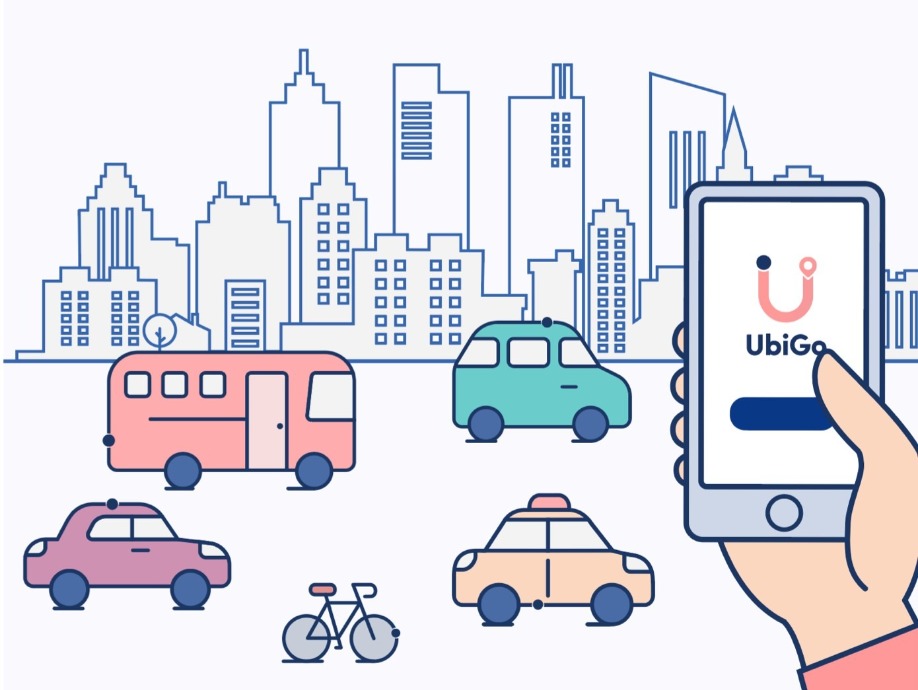
So, in order to challenge car ownership, we need to provide easy access to cars.
Car access is currently siloed in different business models: Rental cars, station-based carsharing, free-floating carsharing, P2P carsharing, OEM based Car-as-a-service or flexible lease concepts and of course company cars and private leasing or financing. The last four access models typically result in a 5 percent utilization, the other 95 percent of time the car is parked at home or at work. Low utilization of course corresponds to a higher demand of vehicles which supports the current main business model for OEMs: To sell products and connected services to specific users. The question is for how long that model is viable.
But the other car access models have other challenges.
Station based carsharing
Station based carsharing offers cars for more or less planned shorter errands with the home or workplace as the starting point. The main challenges can be described in three words: Accessibility, profitability and scalability. The demand is typically much higher during weekends than on weekdays. That means to the operator will lose money on underused cars during the week and loose customers during the weekends, while customers too often won’t get a car when they need one. So, the dynamics during the week is one problem, another is scaling. With very few exceptions such as Zipcar most providers are small and don’t have financial muscles to take risks and scale fast. Buying or leasing cars means a substantial commitment limiting the growth rate for small actors.
Additionally, the business case could be more attractive. With a decent level of usage – let’s say 20-30 percent of 24/7, and with prices people are willing to pay, a car might generate 10-20 percent or €100-€200 per month in positive contribution margin. It’s hard to get much higher than 30 percent utilization for a single business model service without customers starting to complain about low accessibility.
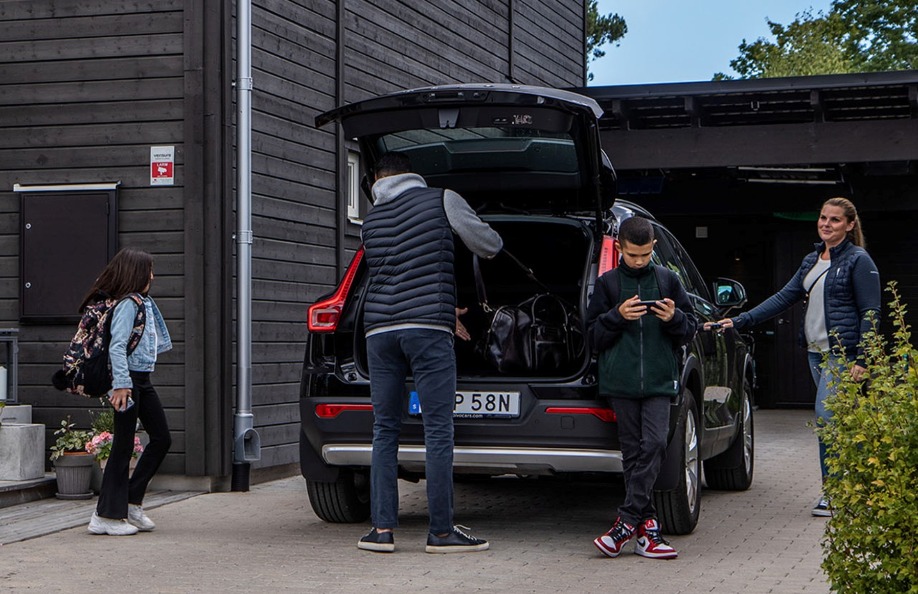
This means that a typical start-up cost of €1k (technology, logistics, admin) can take up to a year to regain. One or two lost months can mean that the car will never generate any profit. That’s why the B2B-market is so interesting for many car sharing companies. If an employer or a real estate company takes the whole risk or covers the fixed cost, they don’t have to care if the cars are used or not. The utilization will be better than for a typical private car, but the actual cost per mile would still be quite high.
New cost-effective technical solutions are improving the calculation. The hardware can be installed in less 30 minutes and the total cost per car, including booking system, can be under €50 per month. That makes it relevant to equip vehicles outside the carsharing business, for instance rental cars that can be insourced when needed.
Free-floating carsharing
The challenges for free floating car sharing, such as DriveNow/ReachNow and Green Mobility, can be even bigger. A station-based car sharing operation can start with just one station and a few cars serving a neighborhood. A free-floating service need to start with hundreds of cars in order to be ubiquitous enough. Those first months or years of operation until enough customers are recruited may never be retrieved in many cities. The concept is also challenged by micro-mobility services that partly addresses the same market. It seems like users are willing to pay almost the same amount of money per minute for an e-scooter as for a car, that is much easier to park for the user and only cost a fraction of what a car cost to own and operate.
Rental car – the grand old lady
Car rental is by far the largest non-lease car access model and has been around for a long time. That is one of the problems. Most companies rely on old IT systems and manual processes, and the price model is complex, to say the least. Even with a pre-booked car, a regular customer needs to spend 10 minutes at the counter before getting on a minibus to the pick-up parking, and it’s almost impossible to know what the final cost of the rent will be. That is one of the reasons why most residents don’t see rental cars as an option if they need a car a couple of days at home.
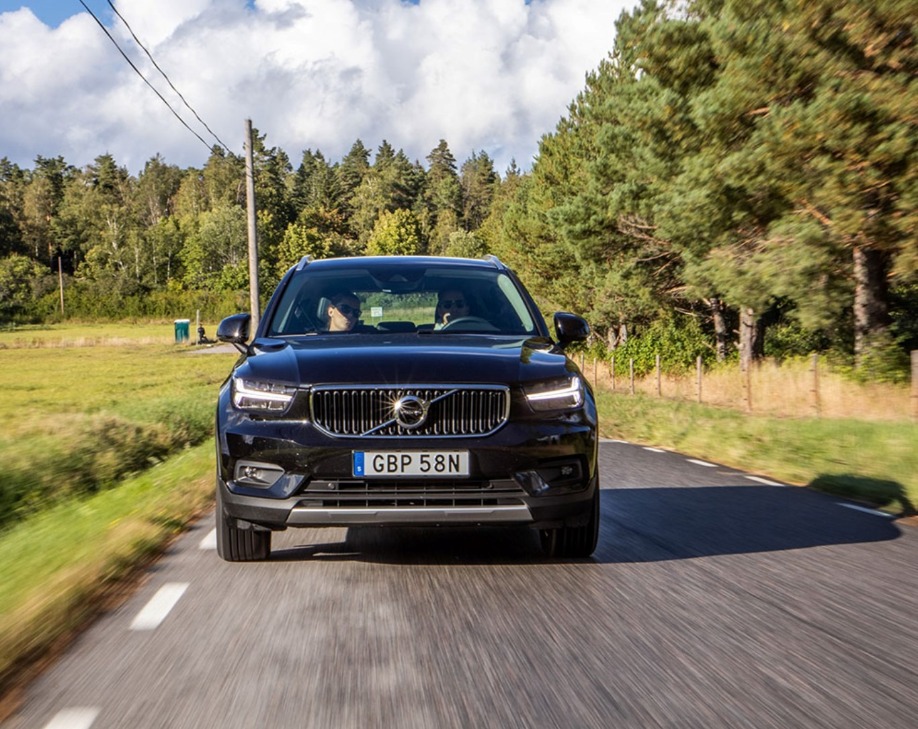
A rental car company has a bottom-line margin of just a few percent, but it manages a huge set of assets. This means that just a small fluctuation in the second-hand market can make the difference between profit and loss. On the other hand, they are good at fleet management and have the ability to almost always provide cars to their customers. With a relatively fast fleet turnover, they can also scale up and down faster than many other actors.
In the last few years some of the rental car companies have started to introduce technical solutions quite similar to car sharing, enabling direct pick-ups and drop-offs at airports. And off course, Avis owns Zipcar and Hertz offer their own car sharing service, Hertz 27/7 in some cities – but both as separate businesses with separate fleets.
Do you want to rent your neighbor’s car?
In theory, renting others’ private cars makes a lot of sense. It’s a god way of making use of existing assets and cars could be made available almost everywhere. In real life, and in most of the markets, uptake of the Peer-to-Peer car sharing has been very slow. Most people are sceptic to rent someone’s private car even if the price are lower. Most people are sceptic to rent out their own car, despite a chance to make some extra money and the extra insurance that is part of the.
P2P platforms such as SnapCar and GoMore have started to offer car leasing as part of the portfolio, as well as key-less solutions, that both make the concept a little bit more like a professional service. Premium sharers will commit to accept all bookings instantly and accept pre-set prices. Normally a car owner does not have to accept a booking and can cancel it if they change their mind. In essence, the less private the first P in P2P is, the more attractive it is.
In most countries, renting out a car can be a subject of taxation and licensing regulation, making P2P car sharing questionable from a legal or economic standpoint, at least formally. Current regulations and tax rules can also make another large pool of underused cars, namely company cars, unavailable for the rental market.
One car, many overlaying business models
The general problem with the different models for car access is the fact that they are separate models, or rather that every car is locked to one model.
The models are also supply driven, rather than demand driven. A car sharing operator will lease a number of cars for a number of years and then try to maximize the usage (but not too much) and revenues according to its business model. It will offer special weekend prices on the fixed number of cars instead of adding (rental) weekend cars, leaving no cars for shorter errands. Disappointed customers will demand more cars at the station, cars that will be unused during the weekdays and so on.
Free floating car sharing services, as well as station based, can optimize the location of the cars based on historical data and advanced algorithms, but it will still be an optimization within the existing fleet. Sub-optimization can only be solved by overlapping business models, hybrid models and effective sharing of shared cars.
The most sustainable car is the car that is used 24/7. The most accessible car is the car that is (nearly) always available. The most efficient and profitable eco system is the one that matches the demand of many customer segments with the supply of many actors.
The car cloud
In the best of worlds, a car can serve residents in the afternoon and evening, be used by a security company during the night, be driven to an office district and be part of a free-floating car sharing fleet or used for business trips by a company at daytime. At an event it can be used by an Uber driver, or maybe be used for delivery. At weekends, the residential car sharing station can be expanded with extra cars or used as a pick-up station for weekend cars that are sourced from a rental car station or a company fleet.
This already starts to happen, although in a small scale and partly driven by the pandemic and rental car companies desperate to find use for their underused fleet.
Consumer and corporate facing service providers such as MaaS operators and individual car sharing and rental car companies will take care of the demand side, but which actors will handle the demand side? Leasing companies, rental car companies, OEMs or totally new actors acting as intermediates running the “car cloud service and clearing house”?
Car-as-an-SLA
But won’t everything change when we get self-driving cars? Yes and no. With the driver out of the equation and cars picking you up instead of being parked waiting for you, nobody really needs to own a car? Well, somebody still needs to own the cars, self-driving or not.
The cost of financing and operating a self-driving car, including user support, extra cleaning, updates etc would still be substantial and in order to cover the cost, the self-driving taxi might need to have paying customers almost 24/7. Are there any operators that would be willing to invest in hundreds of thousands of extra vehicles – just in a single city – to be able handle the rush hours in the morning and afternoon? There are a lot of commuters living or working to far from a good public transport network. Even with more effective first-/last-mail solutions feeding commuters to train stations and a more positive attitude to sharing rides, the demand for cars will be much higher during a small part of the day.
This means that robo-taxis will replace current taxi and ride-hailing services as well as underused bus-lines – and hopefully not bike-trips – but not all the cars that are waiting for its rider outside his or her home in the morning. However, does that car really need to be the same every morning?
As long as the car is as nice and personalized as I want it to be – and where I want it to be – who cares? I would be willing to pay the same amount of money for the same access I get from a personal car. Car ownership is a mobility insurance, or a kind of Service Level Agreement, but today it actually consists of different agreements with a number of actors. I would be happy if someone could offer me a real SLA.
Plus, cars being allocated to the commuter in the mornings and afternoon, can be used by households in neighborhood that commute by mass transit, but need individual transport options in the evening. That would offer local carsharing in areas where today’s car sharing concepts would never be commercially viable and would reduce the number of miles driven with empty robo-taxis from the outside.
Do we even have to wait for level 5 AVs? Car-as-an-SLA is only partly a technical question. The rest is about business models and disrupting the ecosystem.

About the Author:
Hans Arby is the founder of UbiGo, a MaaS pioneer with commercial operations in Stockholm. He has a broad experience in developing and promoting sustainable transport in both the private and public sector. He is a member of the UITP Combined Mobility Committee and lead trainer for the UITP MaaS trainings.
It doesn’t take much to change the surrounding reality
The trend to limit the number of combustion vehicles in cities, and consequently improve air quality and the comfort of life in major centres of population, started a long time before the coronavirus pandemic. London authorities had introduced a fee for driving into the city centre back in 2003. With time, they tightened the regulations and extended the Ultra Low Emission Zone (ULEZ). Since then, many cities around the world have adopted similar regulations, trying to encourage their residents to use means of transport that are more environmentally friendly and beneficial to human health and at the same time discourage the use of private cars.
The introduction of strict and sometimes burdensome laws in the biggest cities is not surprising when we look at air pollution statistics. Harmful emissions generated by transport constitute almost one fourth of all greenhouse gas emissions, whereas poor air quality is currently the fourth leading cause of death around the world, killing 6 million people a year. In 2010, it caused 9,000 premature deaths in London alone.
The global pandemic, lockdown and economic stagnation has made the world draw a deep breath and slow down for the first time in many years. Dolphins have reappeared near the coast of Hong Kong, residents of Indian cities had a chance to see far-away mountains of the Himalayas for the first time in 30 years, and clouds of acrid smog over large agglomerations stopped blocking sun rays for a while. The London mayor, Sadiq Khan, has announced that in the last few months, toxic air over the city fell by 50% in some spots due to reduced traffic. The immediate environmental effects of a temporary slowdown experienced by the world engulfed in the pandemic have shown us that it does not take much to change the surrounding reality. All around the world, authorities drew conclusions from the current situation and took decisive steps. The authorities of Milan, Italy, have announced that they do not intend to go back to pollution standards from before the pandemic. They want to limit the number of parking spaces in the city, widen the pavements and build new bicycle paths. The mayor of London took a similar stance and said that lower air pollution had to be maintained after the pandemic.
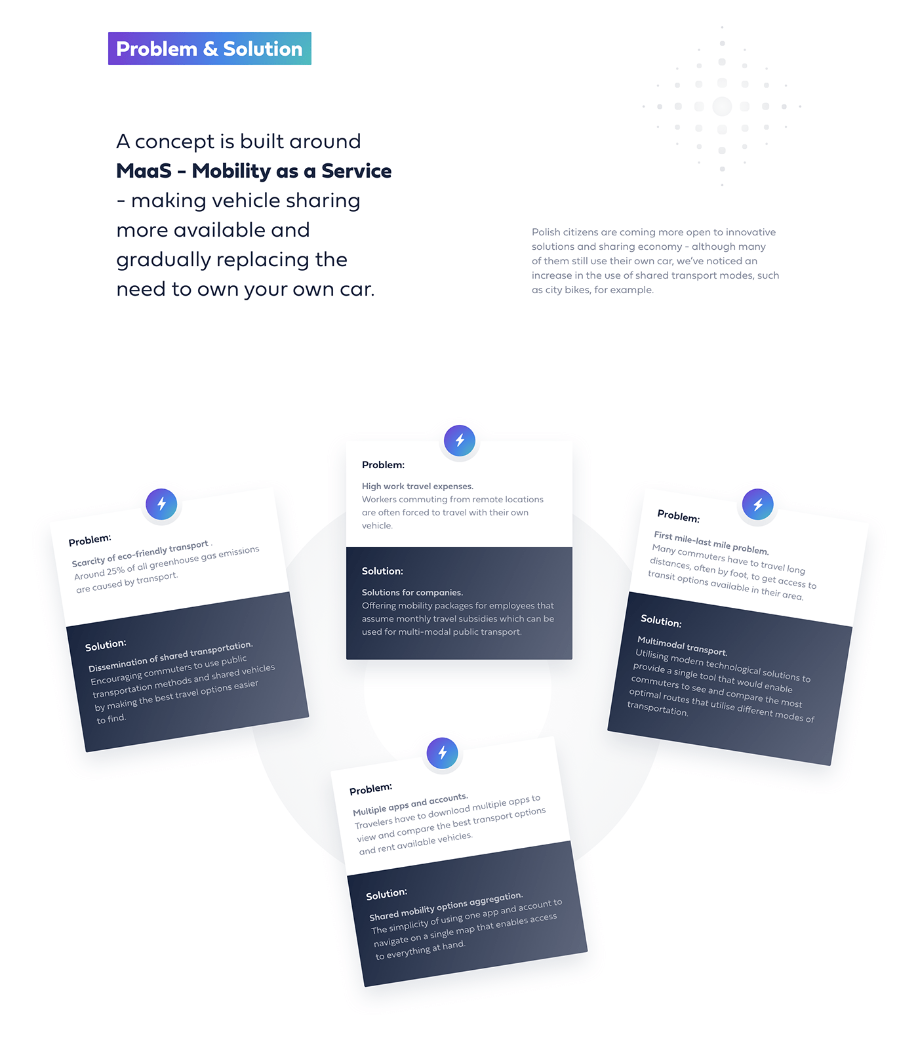
So how can we make big cities cleaner, more passable and more attractive? Shared transport can be one of the solutions. Electric cars, motor scooters, kick scooters and bicycles rented by the minute, as well as public transport, are a comfortable and healthy alternative to private cars that are forced out of cities, which makes using them unprofitable and inconvenient. Nowadays, remote work has become the new standard and young people value flexibility and freedom of movement, so a private car may become an unnecessary and expensive burden. What comes to our rescue is a service known as MaaS (Mobility as a Service), which combines all means of shared transport, public transport, a travel planner and a system to pay for all these services, available in one application that is integrated with the city. It is not a technology of the future. The first initiatives of this type were launched a few years ago in Scandinavia. In 2019, Berlin introduced Jelbi, an application managed by the Berlin Transport Corporation (BVG). It encompasses all forms of shared transport, both public and private. Since then, cities such as Munich, Zürich, Bern and Basel became interested in this project and decided to have their local equivalents of Jelbi developed.
It is estimated that by 2025, the value of the MaaS market will reach about 230 billion dollars, with the compound annual growth rate (CAGR) of 32%. The appearance of electric cars, kick scooters, motor scooters rented by the minute, P2P taxis, such as Uber, and applications which aggregate all these means of transport, has opened up opportunities undreamed of just a few years ago. The driving force of this global trend are also autonomous vehicles. In the near future, they may completely transform the way in which we move around the city. Technological progress, smart city initiatives and constantly growing urbanization will soon make MaaS not only an optimal, but also a necessary, mode of transport.
“The outbreak of the pandemic accelerated changes which have been visible in the MaaS market for some time. Due to the size and variety of the transport market, fulfilling people’s needs with regard to movement and maintaining profitability requires open and flexible cooperation between different entities in the market. More and more companies engaged in MaaS are aware of that and actively look for business partners in order to optimize costs (e.g. with regard to IT systems) and create added value together. In the future, the key to ensuring both profitability and customer satisfaction will be advanced and expensive solutions which make use of predictive models and innovative tools for route planning. MaaS is first of all a technology,” says Radosław Nielek, Ph.D., Eng., R&D Director at Vooom.
The perfect vision of the future would be harmonious and organic cooperation between city authorities and private shared transport operators, so that they could build one urban ecosystem. It is estimated (IPSOS) that a private car is used for about 63 minutes a day and is not used at all for 67 days a year. Therefore, such a car is useless for 97% of the time. When cities are fully integrated with MaaS applications, the need to own a car will disappear. It will simply become a less convenient and a more expensive alternative. Thanks to it, there will be no traffic jams, pedestrians will have more space and air quality will significantly improve. The city will be given back to its residents.
Nowadays, it is corporations that dictate the pace of life in big cities. In the morning, around 7 o’clock, thousands of cars drive out on the streets so that people can get to work. There are enormous traffic jams and acrid exhaust fumes rise up to the sky. The same situation is repeated in the afternoon, when tired employees go back home. Data shows that in Poland, 70% of cars are company vehicles, which means that corporations are to a large extent responsible for bad air quality and traffic jams in cities. A better alternative to expensive and environmentally unfriendly fleet vehicles could be a monthly subscription for an MaaS application, treated as an employee benefit. Every month, employees would get a specific amount to spend on shared transport in a given application. In this way, employers could significantly reduce the amount of money spent on transport to the office and on parking spaces, whereas the city would get rid of unwanted exhaust fumes and cars. Moreover, organizations with environmentally friendly policies have a better image: consumers are more willing to choose brands that have a mission and are guided by corporate social responsibility.
The global pandemic has shown us how little is needed to have a real and immediate impact on the condition of our planet. We already have the technology required to ban combustion cars from cities. Thanks to MaaS applications, such as Vooom, Jelbi or Trafi, ditching your own car and opting for shared transport is easy and convenient and the user does not have to compromise. City authorities and companies which consciously introduce environmentally friendly policies are more and more willing to cooperate with the MaaS market. For the younger generation, car rental by the minute is nothing surprising. We have all the tools and possibilities required to clean and change the world. We should learn a lesson from the last few months. We cannot let acrid exhaust fumes, enormous traffic jams and air pollution become our sad everyday reality once again.
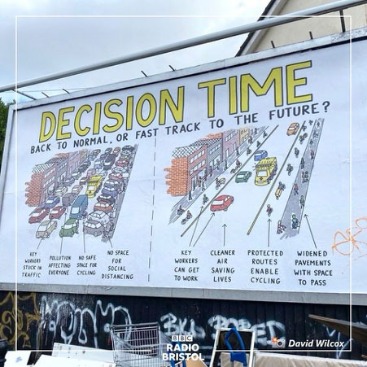
According to a report by the Samar research agency, entitled The Polish Passenger Car Market Yesterday and Today (2000 vs. 2020), the share of companies in the registration of new cars has grown from 4.6% to 70.3%! All the signs are that it is companies and employers who can play a significant role in improving the quality of life in cities. After all, maybe cities are built for people, not cars.
By Włodzimierz Łoziński - CEO Vooom
Vooom is a leading MaaS (Mobility-as-a-Service) mobile application developed in Poland and owned by Michal Kicinski’s, known also as the co-creator of CD Project game studio, which produced the outstanding Witcher game series. Vooom is a platform that enables fast and efficient rides in 12 biggest Polish cities by gathering both public transport and shared vehicles on one map, allowing individual users in major Polish cities to move quickly and comfortably by means of shared vehicles, public transport and taxis, all accessible from one application. All currently available cars, electric motorbikes, scooters, bicycles, and public transport are on one map.

With the support of the State of Georgia, Jackson County and City of Commerce, SK Innovation announced its plans to hire more than 1,000 skilled American workers by the end of 2021 as it prepares for initial production at the first of two electric vehicle battery plants being built in Commerce, about 70 miles northeast of Atlanta.
In one of the largest economic projects in Georgia's history, SK Innovation affirmed its long-range investment plans for the facility that would make Georgia one of the largest hubs of EV battery manufacturing in the world.SK Innovation recently reached a hiring milestone with the on-boarding of its first 60 employees at the Commerce site. These employees include production supervisors, production/process/electrical engineers and quality/logistics specialists who will set up, work and serve as the trainers for the EV battery production workforce at the two SK Battery America plants under construction at the site.
SK Innovation also recently achieved key construction milestones at the Georgia site with the completion of the exterior of its first manufacturing plant and ground breaking on the second plant. Together, the two SK Battery America plants will have capacity to make enough battery cells each year to power the equivalent of more than 300,000 electric vehicles.
“If you drive along I-85 northeast of Atlanta, you can't miss the progress taking shape at the new SK Innovation facilities in Jackson County. With today's announcements, SK Innovation is well on their way to fulfilling the $2.6 billion investment commitment and 2,600 promised jobs they will create in our state,” said Commissioner Pat Wilson of the Georgia Department of Economic Development.SK Innovation, South Korea's largest energy company, is building two EV battery plants at the Georgia site as part of a $2.6 billion investment in its US battery business that will directly create more than 2,600 permanent jobs in the Jackson County area by 2024. The first SK Battery America plant is scheduled to begin initial operations in 2021 with mass production in 2022.
A second plant at the same site is expected to begin mass production in 2023. As the market for electric vehicles continues to grow, SK Innovation is committed to making Georgia a world leader in EV battery manufacturing.
The new jobs that will be created in Jackson County include a range of technical roles from production operators to senior engineers focused on manufacturing highly sophisticated lithium-ion battery cells at scale. To help begin the process of hiring and training workers, SK Battery America has signed a partnership agreement with Quick Start and Lanier Technical College in Georgia.SK Battery America, SK Innovation's US subsidiary, began initial hiring and training this year of employees at the Georgia site with plans to have more than 150 employees by the end of this year. It anticipates hiring another 900 employees next year. SK Innovation is an affiliate company of Seoul-based SK Group, South Korea's third-largest conglomerate.
Kia Motors Corporation is continuing its efforts to diversify mobility services with the launch of a new mobility service, ‘KiaMobility’. The dealer-led car usership service allows users to rent vehicles from dealers for just a single day or up to a whole year.
‘KiaMobility' offers a new mobility option at a time when people are seeking new modes of transportation following the COVID-19 outbreak. The company has developed its own fleet management platform for the mobility service, allowing collective operation of vehicles at the dealership. The platform is designed to provide personalised service for customers to reserve vehicles of their choice, pay via a mobile app, and visit the dealer for pick-up and drop-off of the vehicles, which undergo thorough sanitation to ensure safety.
‘KiaMobility' is first being launched at 16 locations through dealerships in Italy and Russia. Following the pilot scheme, Kia plans to expand the service next year in Europe and other regions such as Africa, Asia, Latin America, and Middle East.Kia announced its shift to become a provider of personalised, customer-centric and sustainable mobility services under the ‘Plan S' strategy it revealed in January. The plan outlined the company's intentions to develop a diverse range of mobility services and popularise electric vehicles worldwide.
In August, the company also announced plans to expand partnerships with global mobility companies to meet the diverse needs of its customers worldwide.In Korea, Kia operates the ‘Kia Flex' vehicle subscription program, with a fleet of up to 200 vehicles available for use. In Europe, the company established ‘WiBLE' car sharing service in 2018 to enable users to rent and return vehicles at designated locations with its ‘free-floating' system.
Kia also provided 200 e-Niros to the car-hailing firm Lyft in North America last year, and the company partnered with companies such as Grab, Ola, and Revv to prepare for changes in the mobility service domain in emerging markets.
With the rapidly expanding interest in heavy-duty electric trucks, Toyota Motor North America (TMNA) and Hino USA have agreed to jointly develop a Class 8 fuel cell electric truck (FCET) for the North American market.
The companies will leverage the newly developed Hino XL Series chassis with Toyota's proven fuel cell technology to deliver exceptional capability without harmful emissions. This collaboration expands upon the existing effort to develop a 25-ton FCET for the Japanese market which was announced earlier this year. The first demonstration vehicle is expected to arrive in the first half of 2021.
“A fuel cell powered version of the Hino XL Series is a win-win for both customers and the community. It will be quiet, smooth and powerful while emitting nothing but water,” said Tak Yokoo, Senior Executive Engineer, Toyota Research and Development. “Toyota's twenty plus years of fuel cell technology combined with Hino's heavy-duty truck experience will create an innovative and capable product.”
“Expanding upon our proud heritage of the Hino powertrain, Toyota Fuel Cell Technology offers our customers a commercially viable, extended range, zero emissions vehicle in the near term,” said Glenn Ellis, Hino's Senior Vice President Customer Experience. “Hino shares a common focus with Toyota when it comes to durability, reliability, and innovation with the customer at the centre of design which makes this collaboration a game changer.”
TaaS Magazine and website offers advertisers fantastic opportunities to reach those involved in the Connected & Autonomous Vehicles and Future Mobility Industry. With packages to suit every budget, take a look at our media kit and get in touch to get involved with the TaaS portfolio of products.
Contact us on the details below to talk about your editorial, advertorial or advertising needs.
T: +44 24 7671 8970
Published by: Angel Business Communications Ltd, 6 Bow Court, Fletchworth Gate, Burnsall Rd, Coventry CV5 6SP. T: +44(0)2476 718970. ISSN 2516-5895
All information herein is believed to be correct at time of going to press. The publisher does not accept responsibility for any errors and omissions. The views expressed in TaaS magazine are not necessarily those of the publisher. Every effort has been made to obtain copyright permission for the material contained in this publication. Angel Business Communications Ltd will be happy to acknowledge any copyright oversights in a subsequent issue of the publication. Angel Business Communications Ltd © Copyright 2018. All rights reserved. Contents may not be reproduced in whole or part without the written consent of the publishers.

